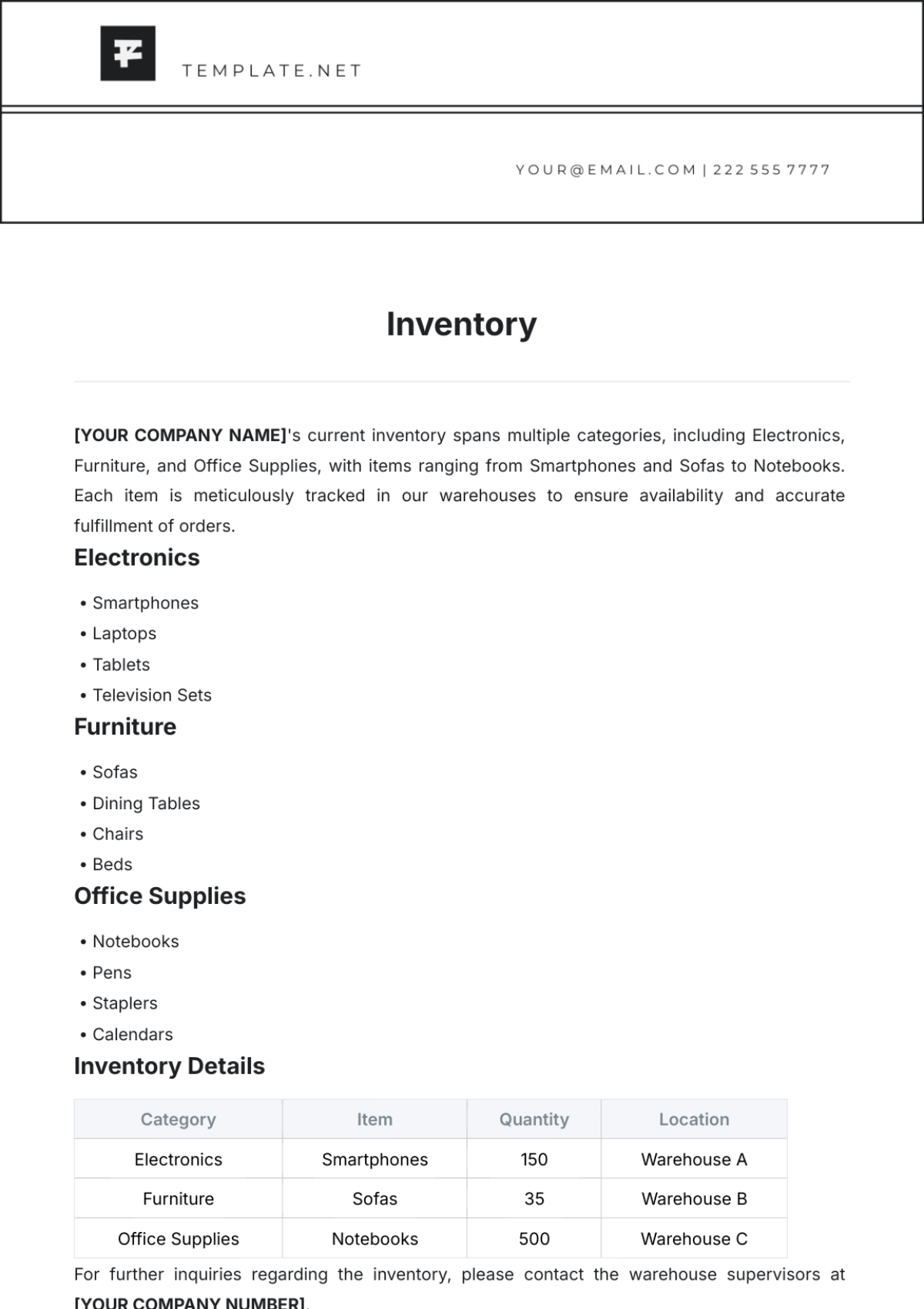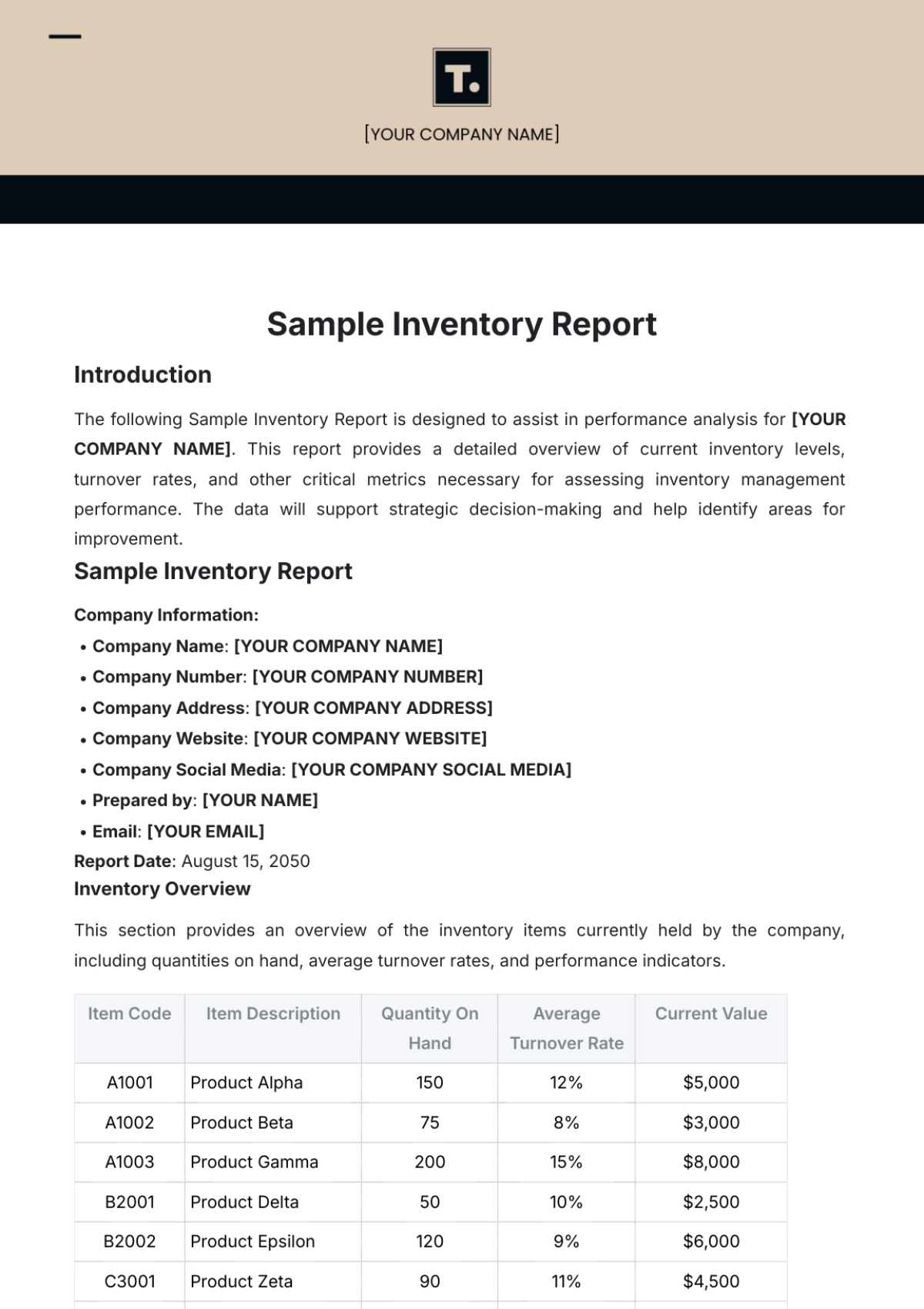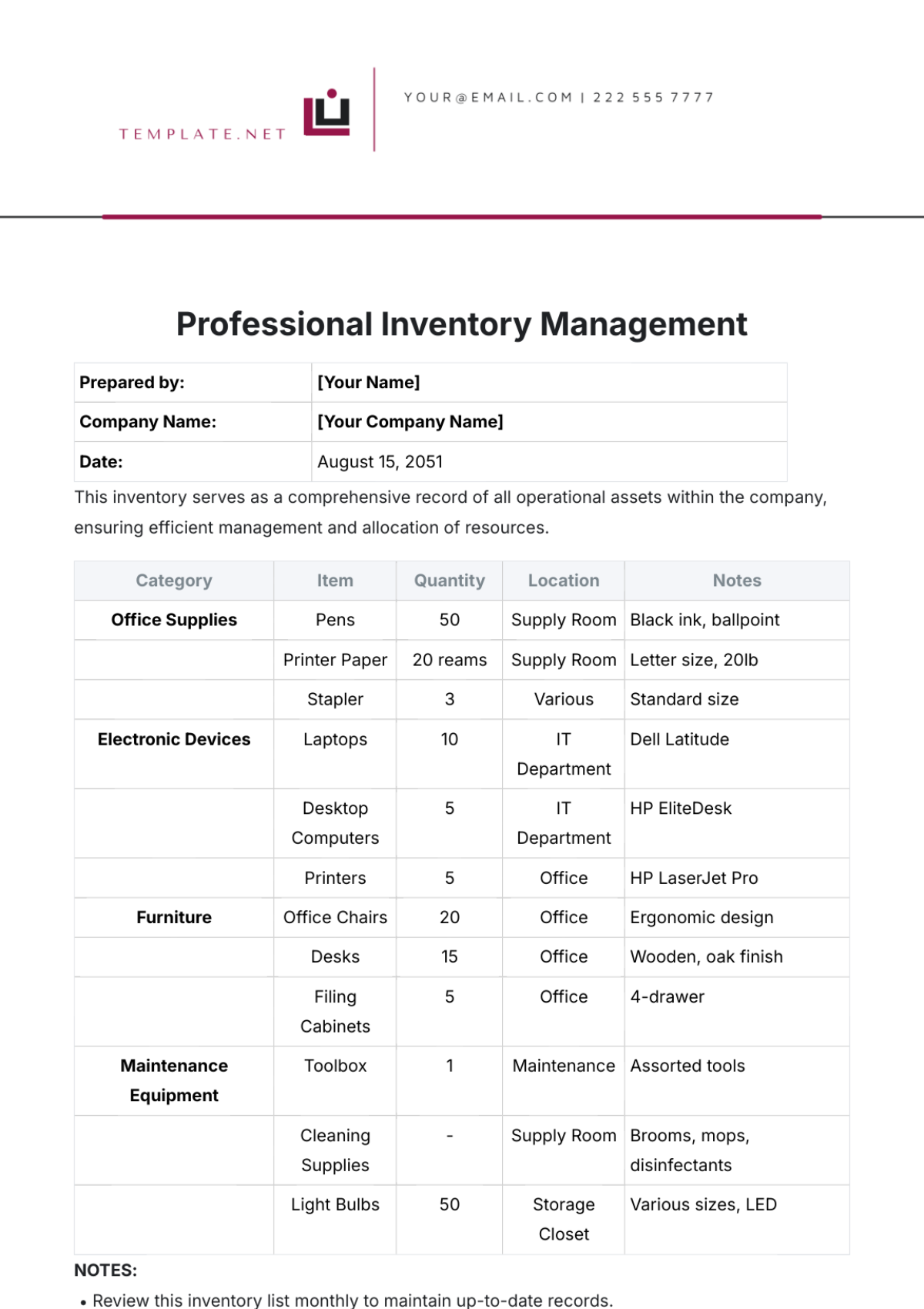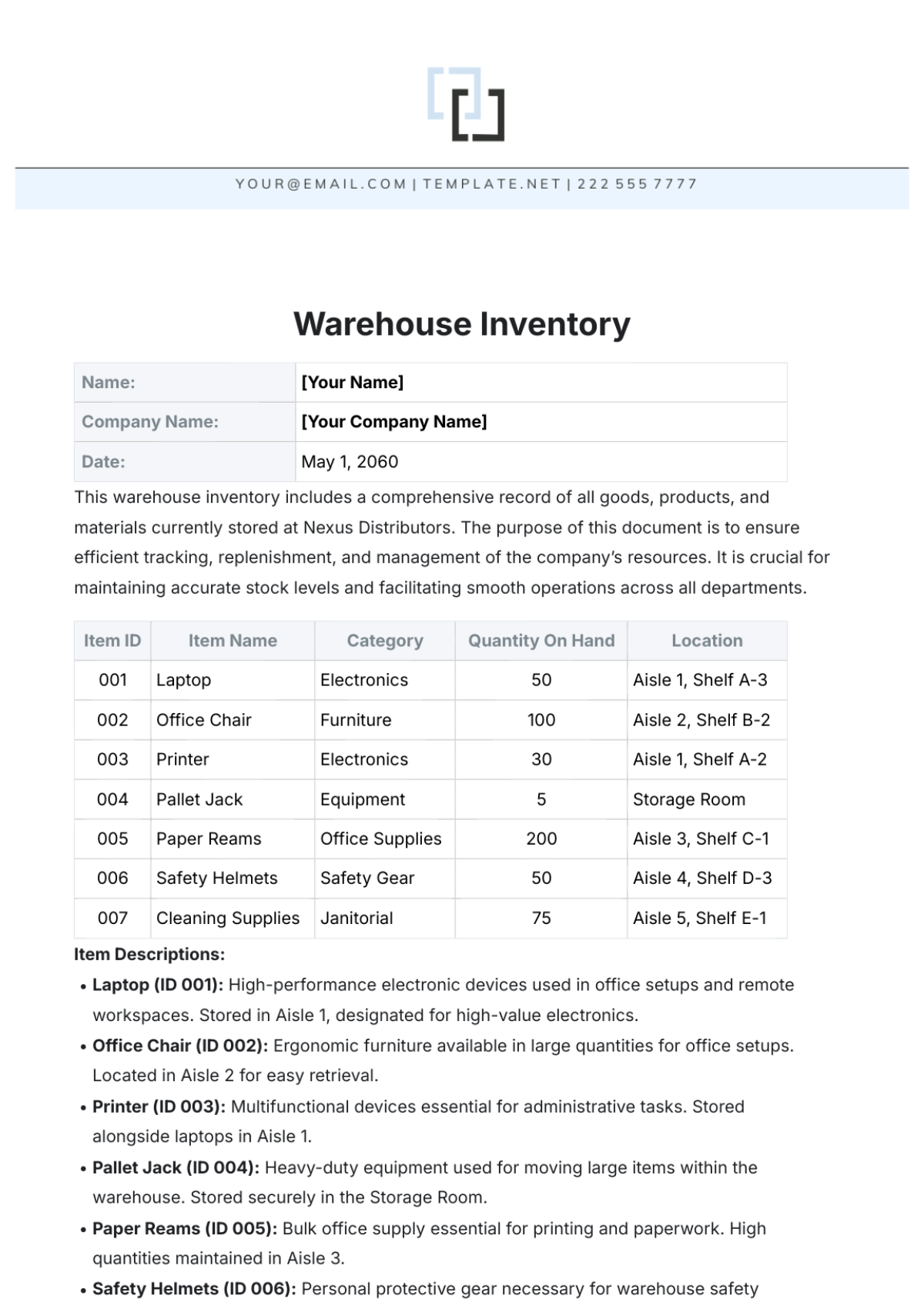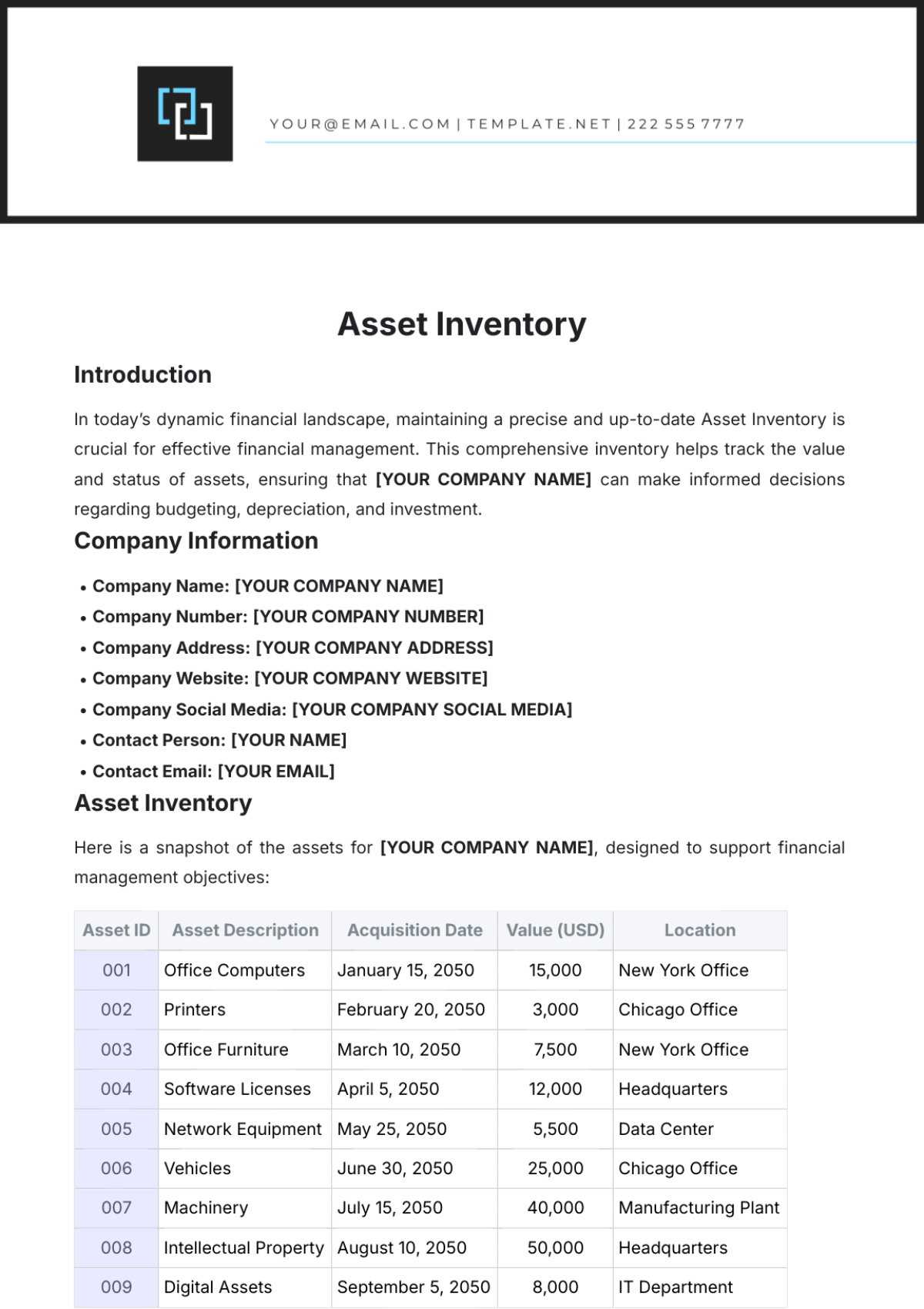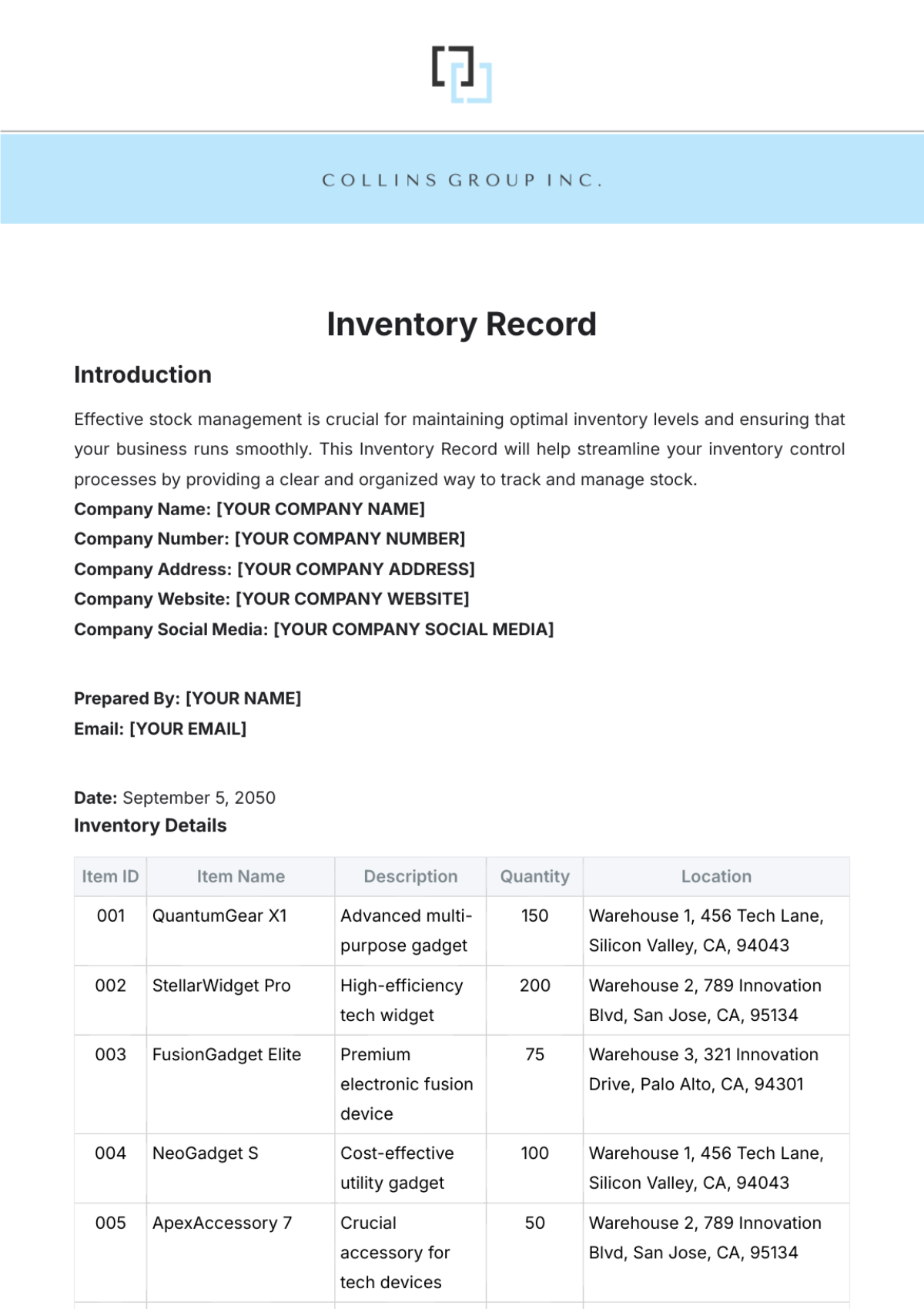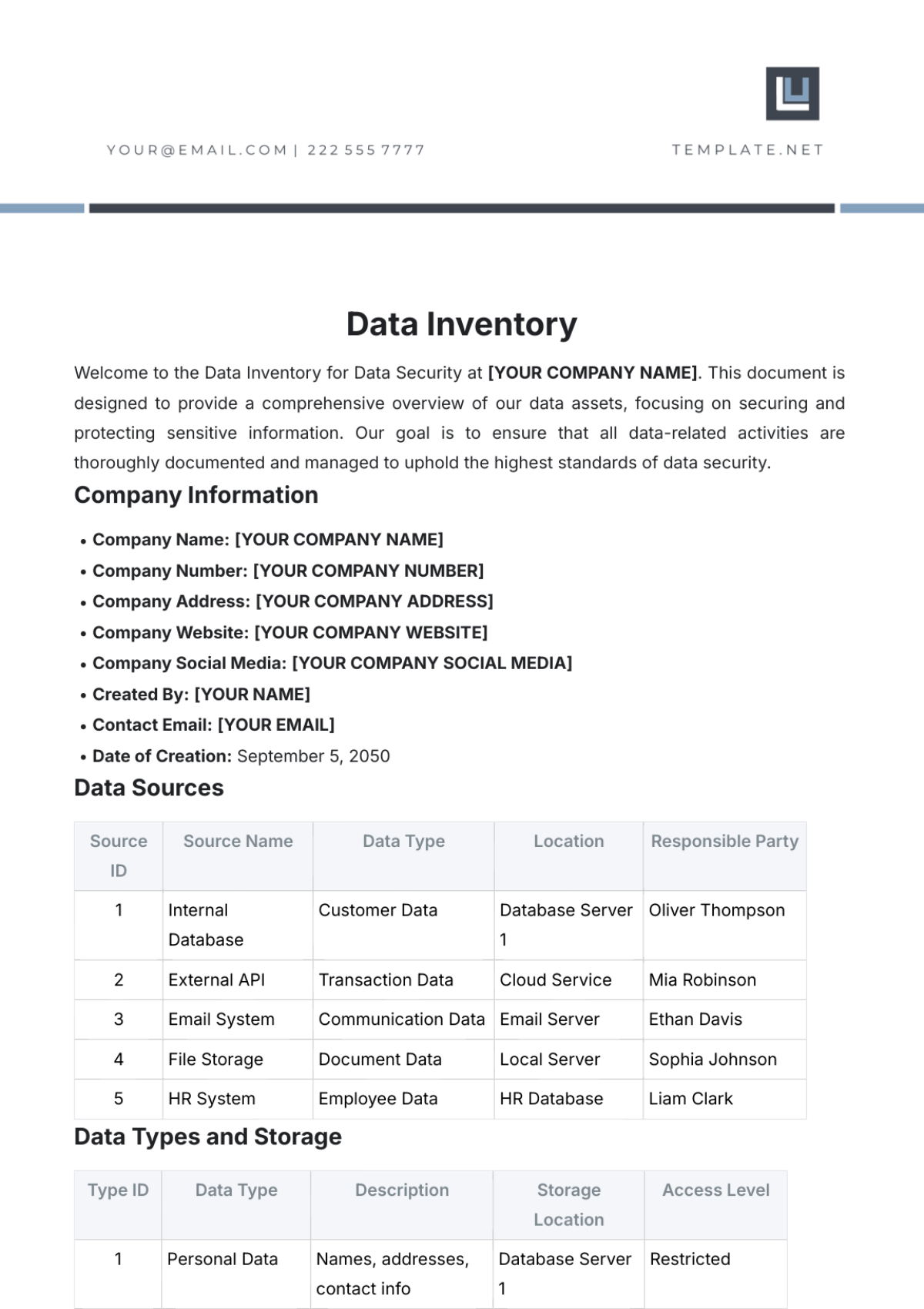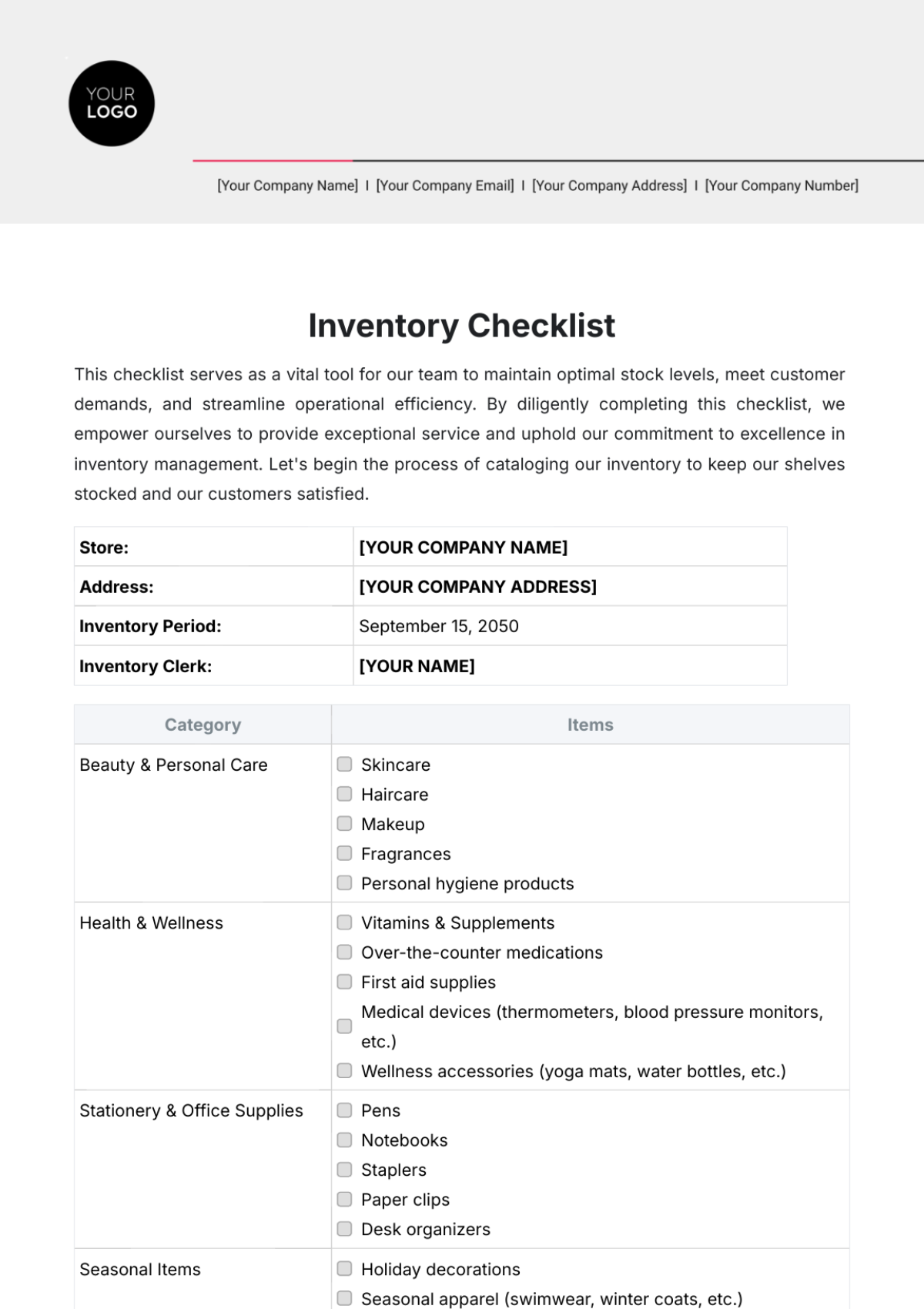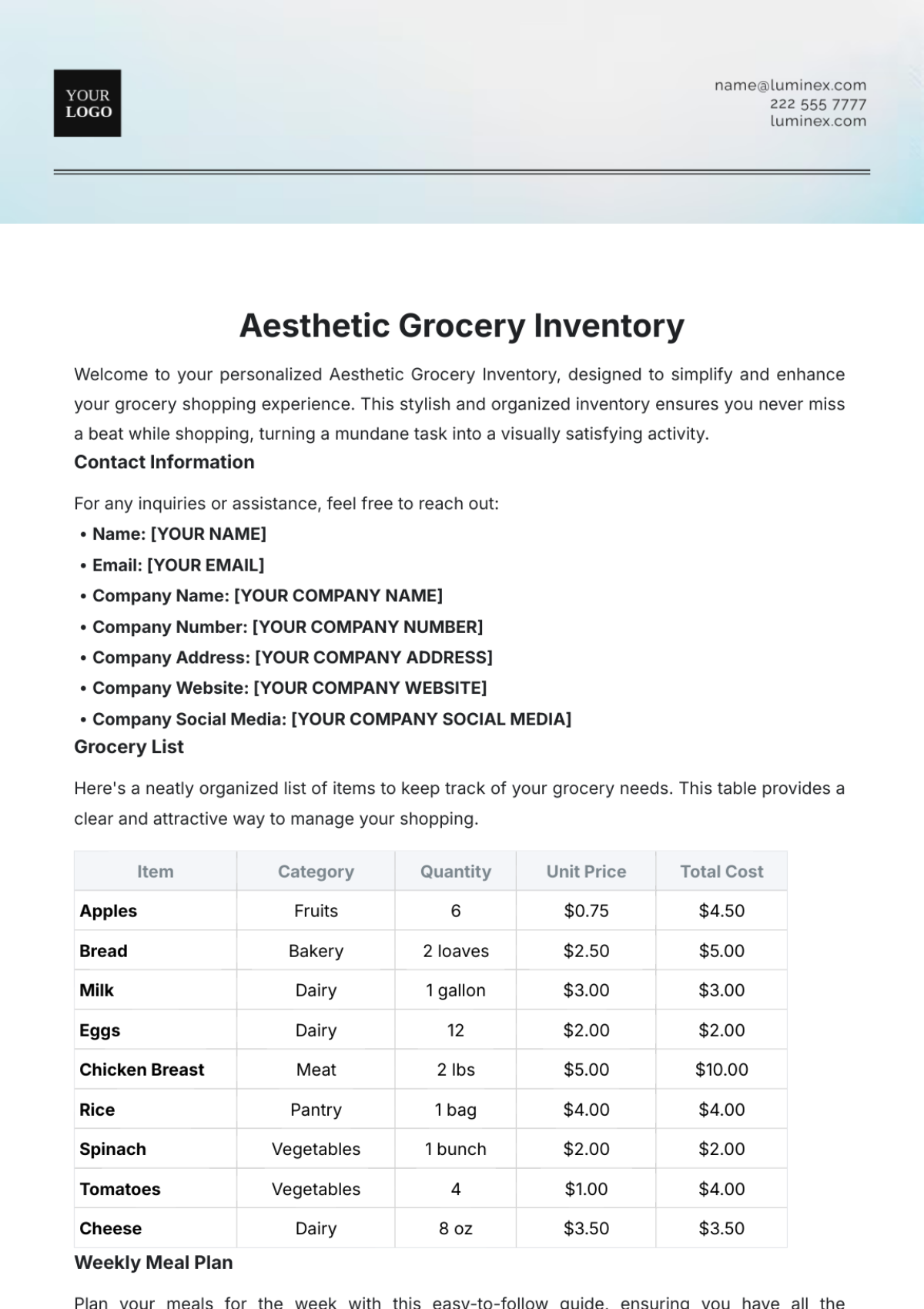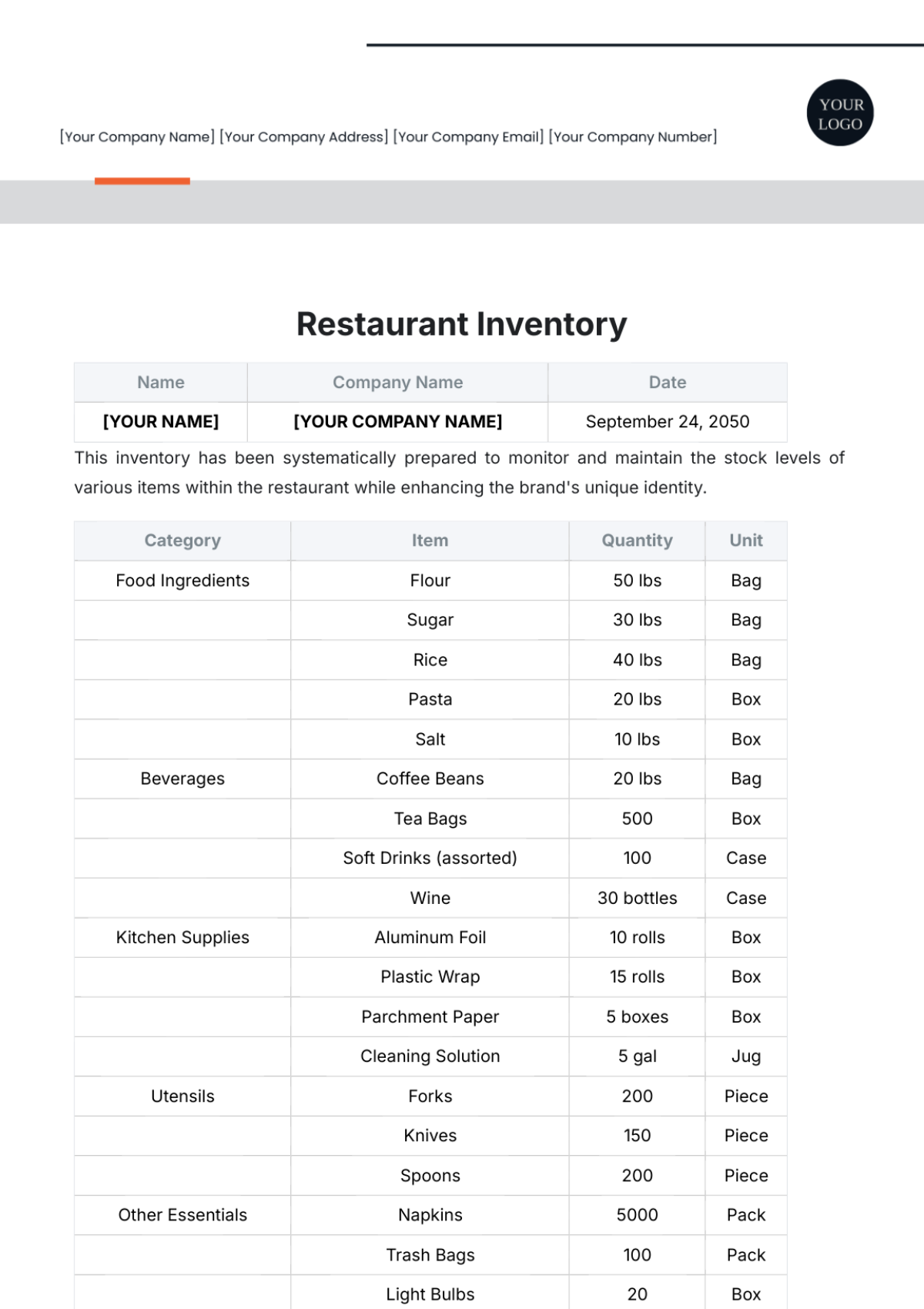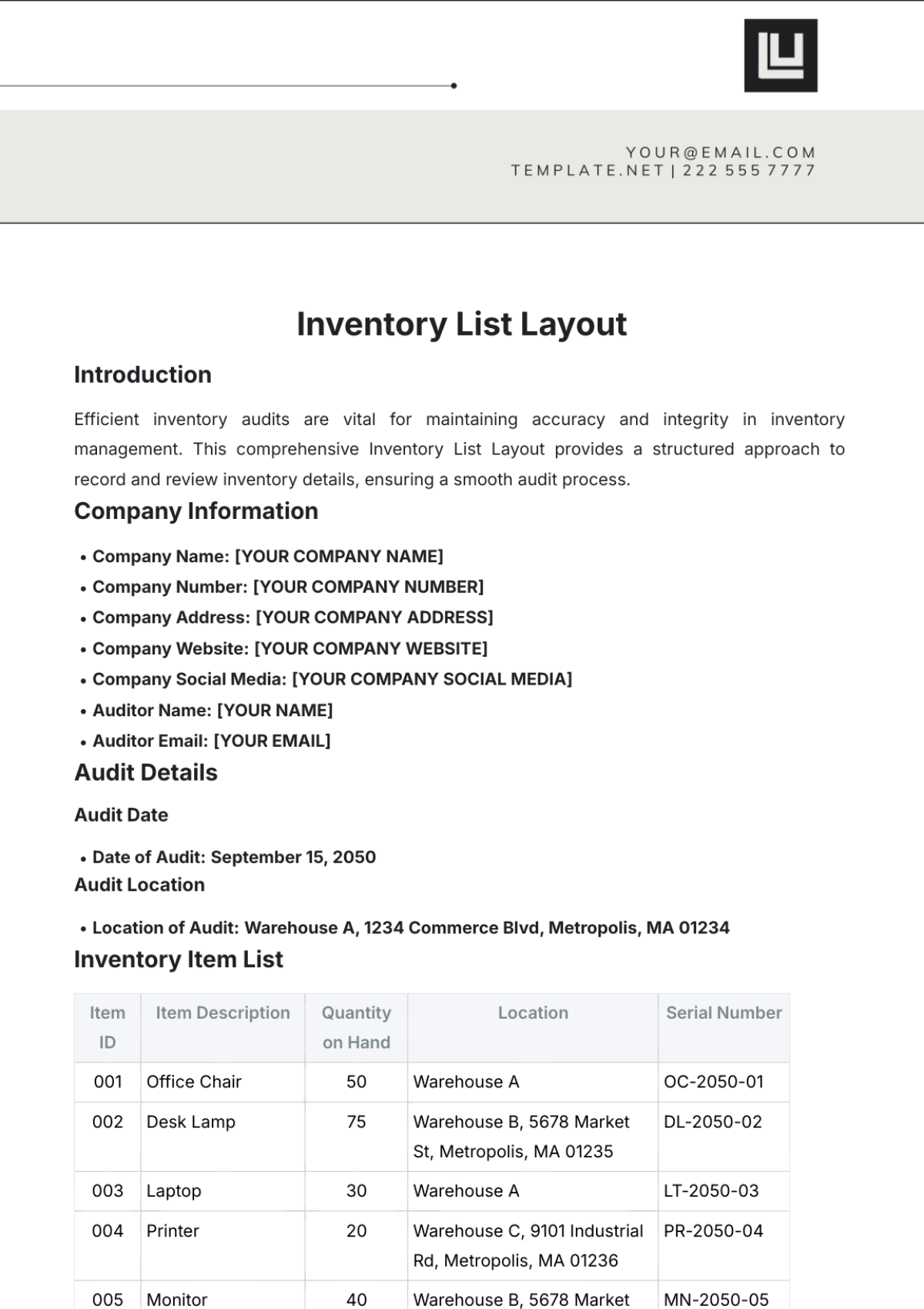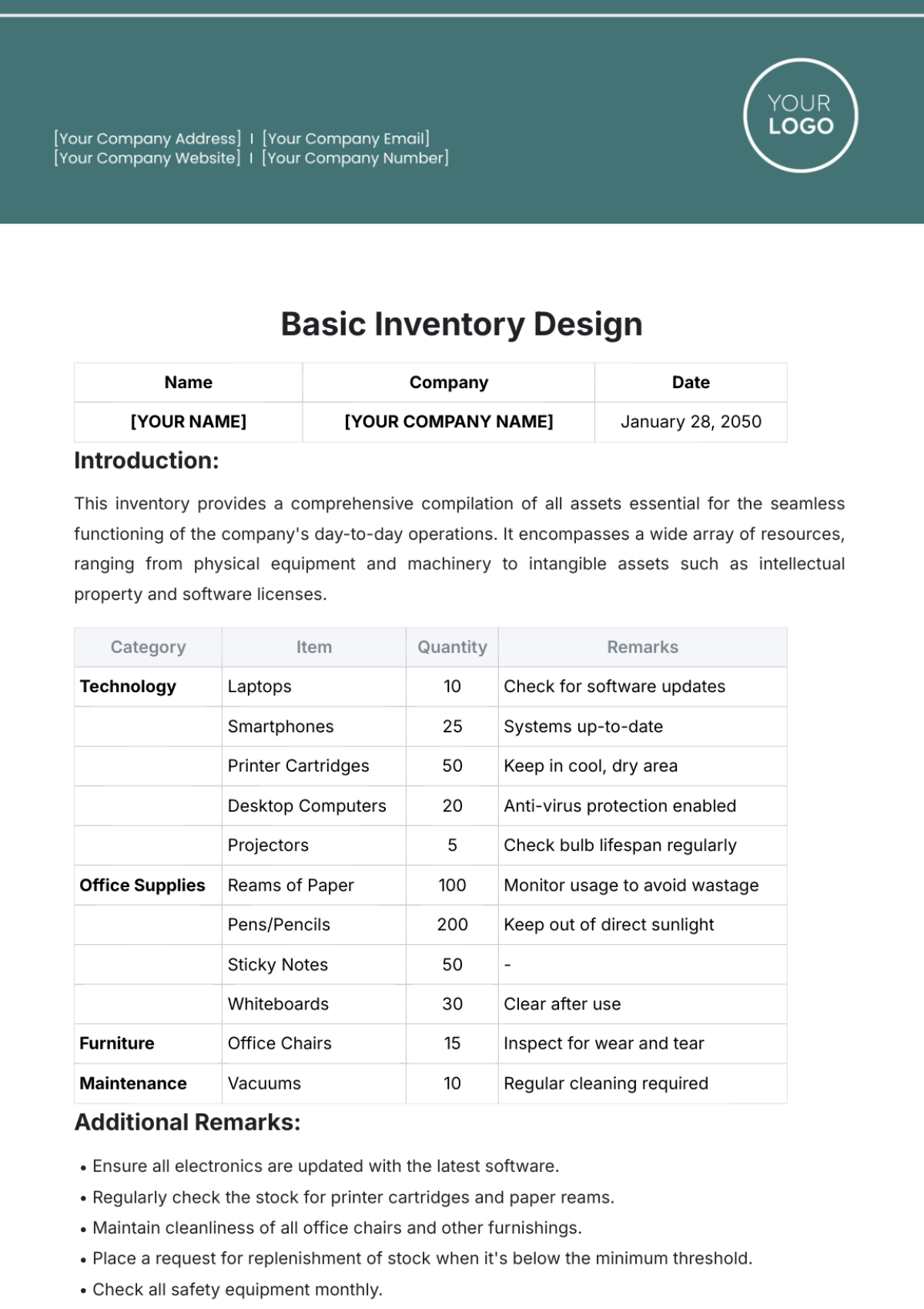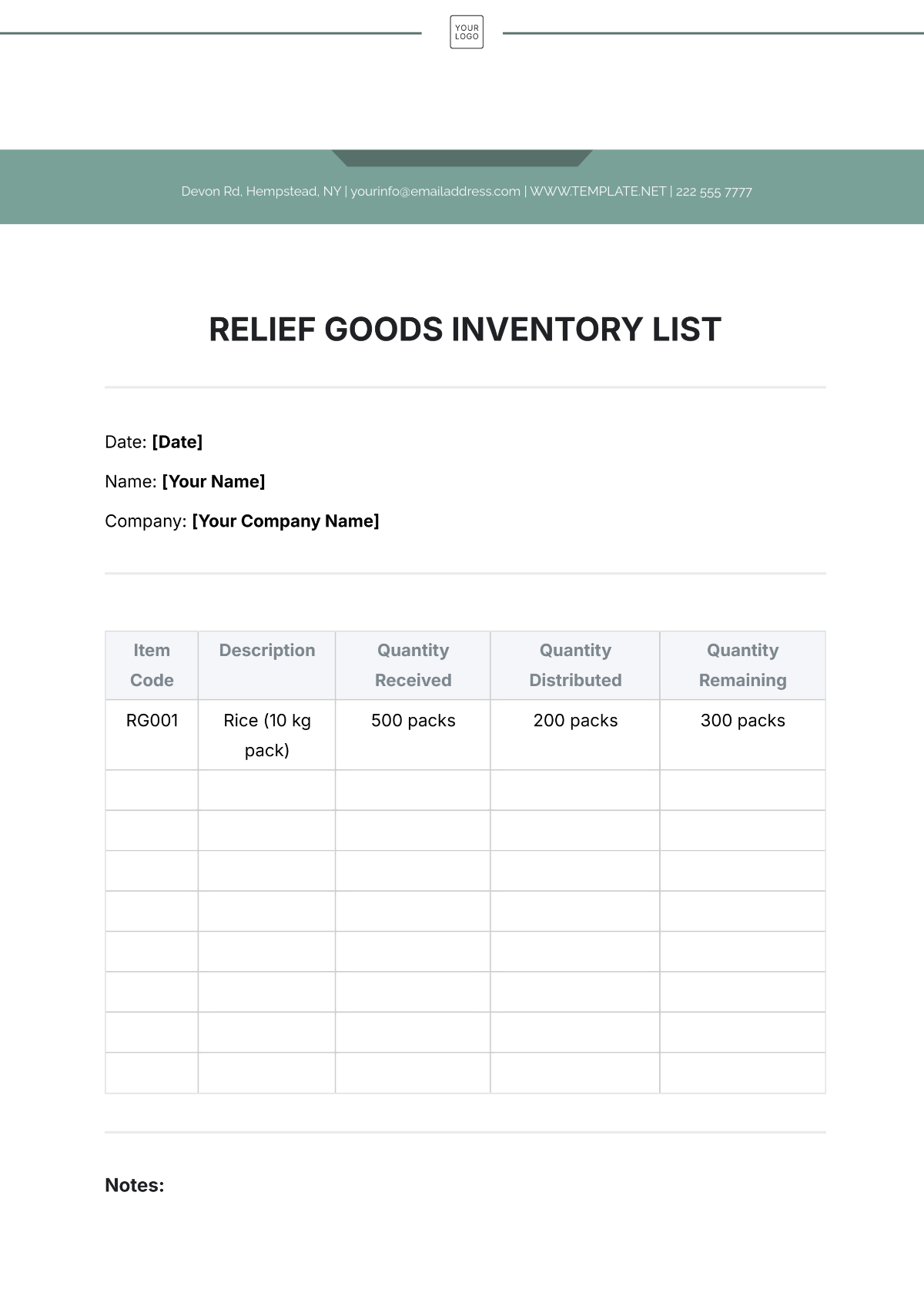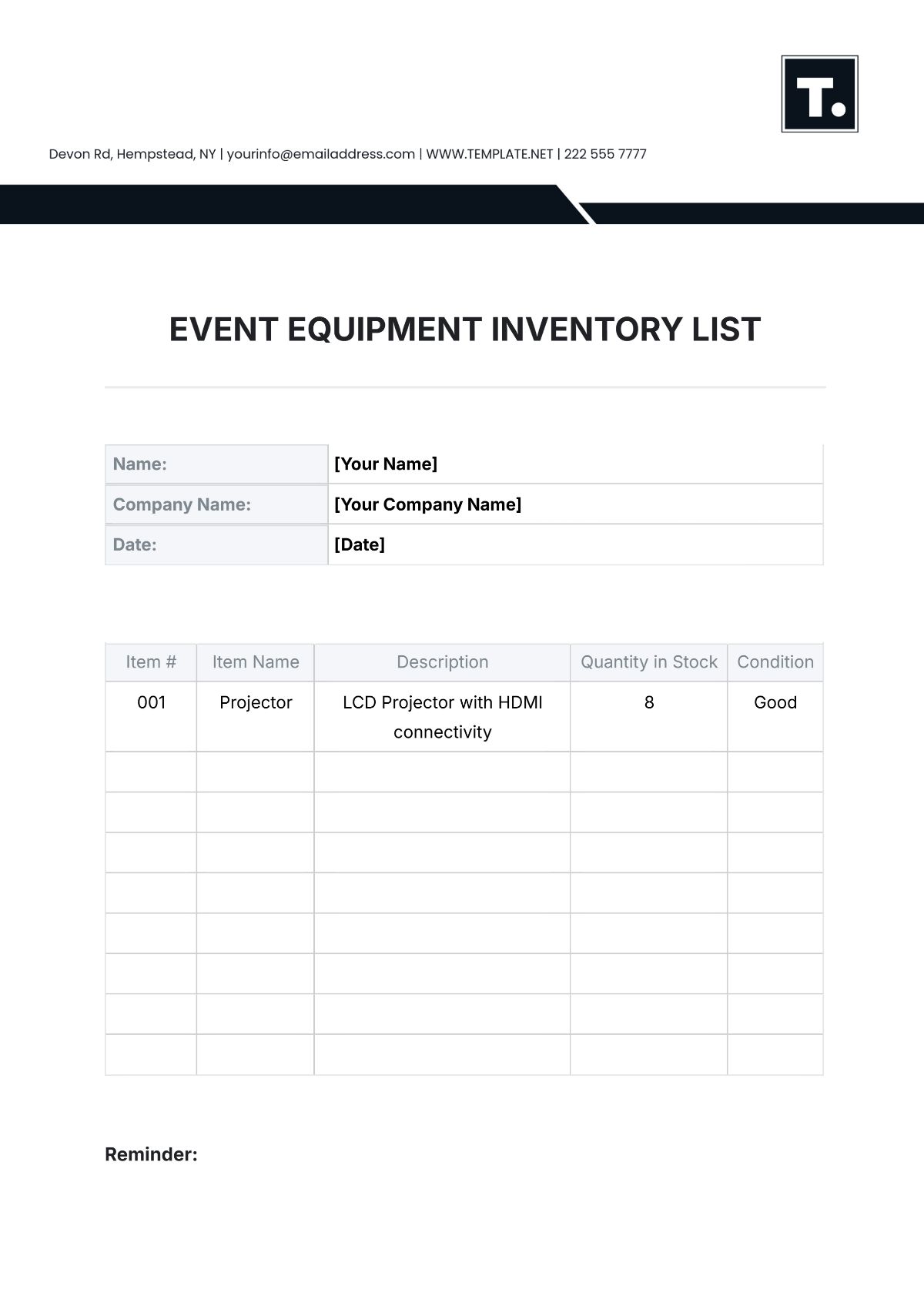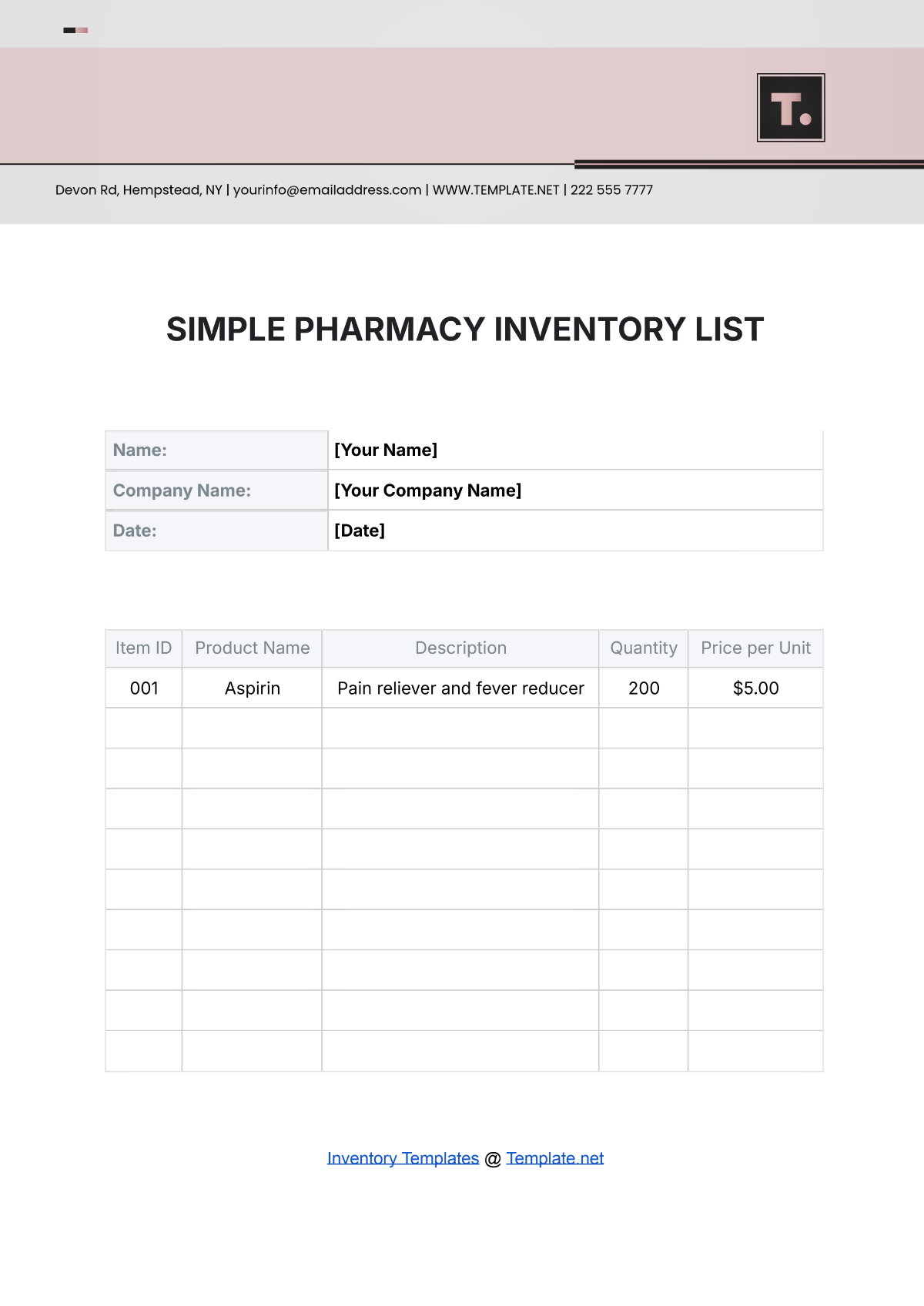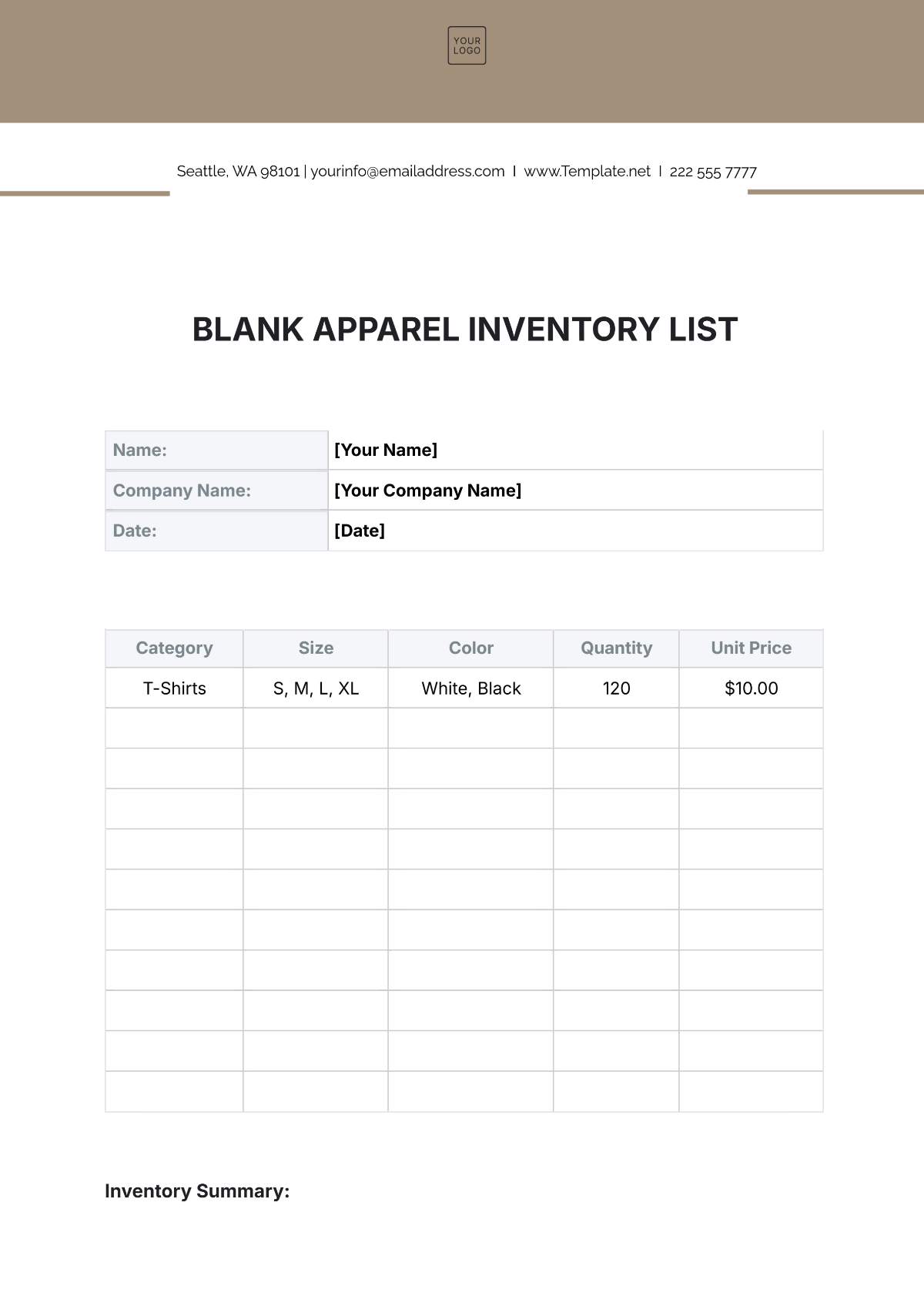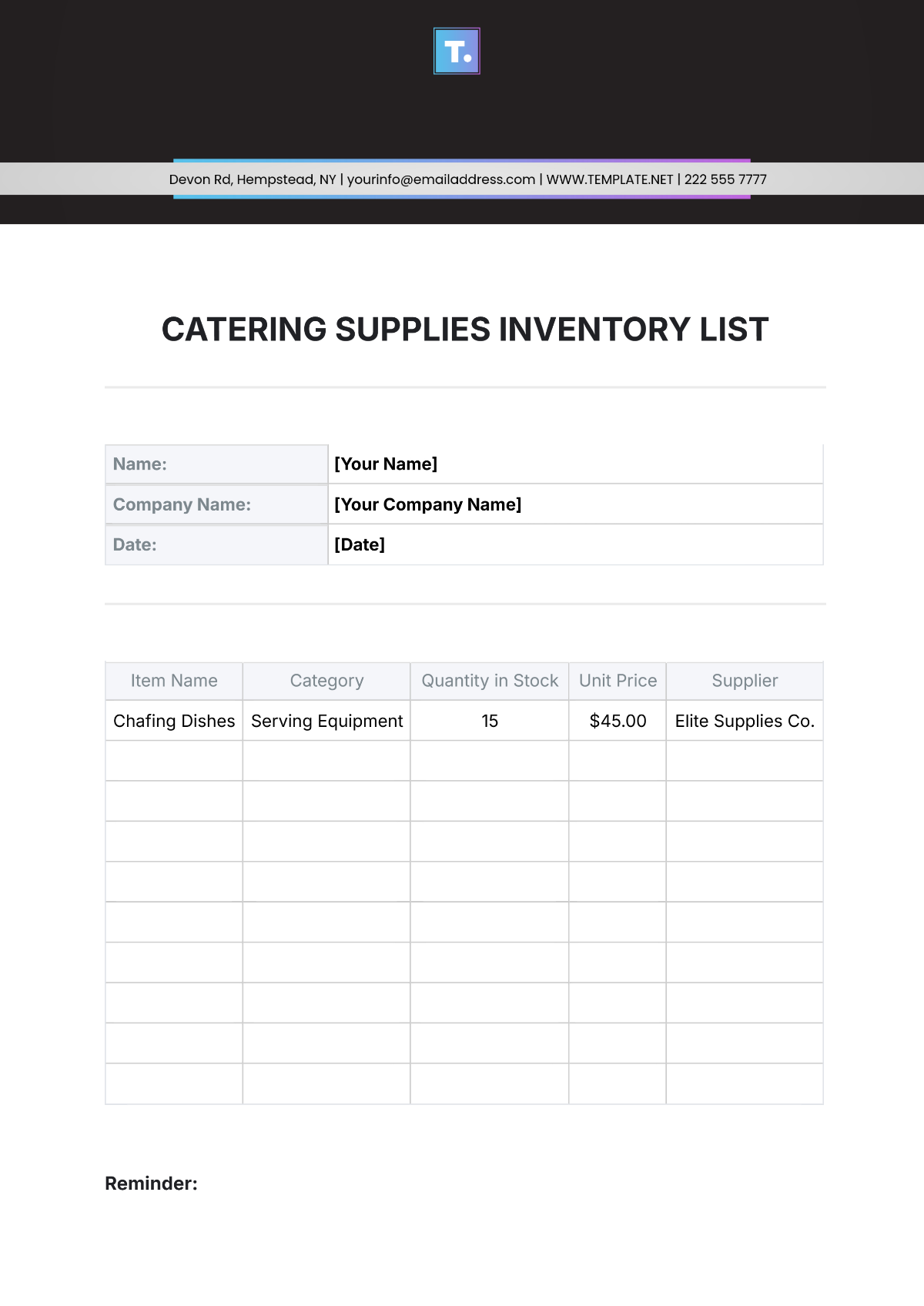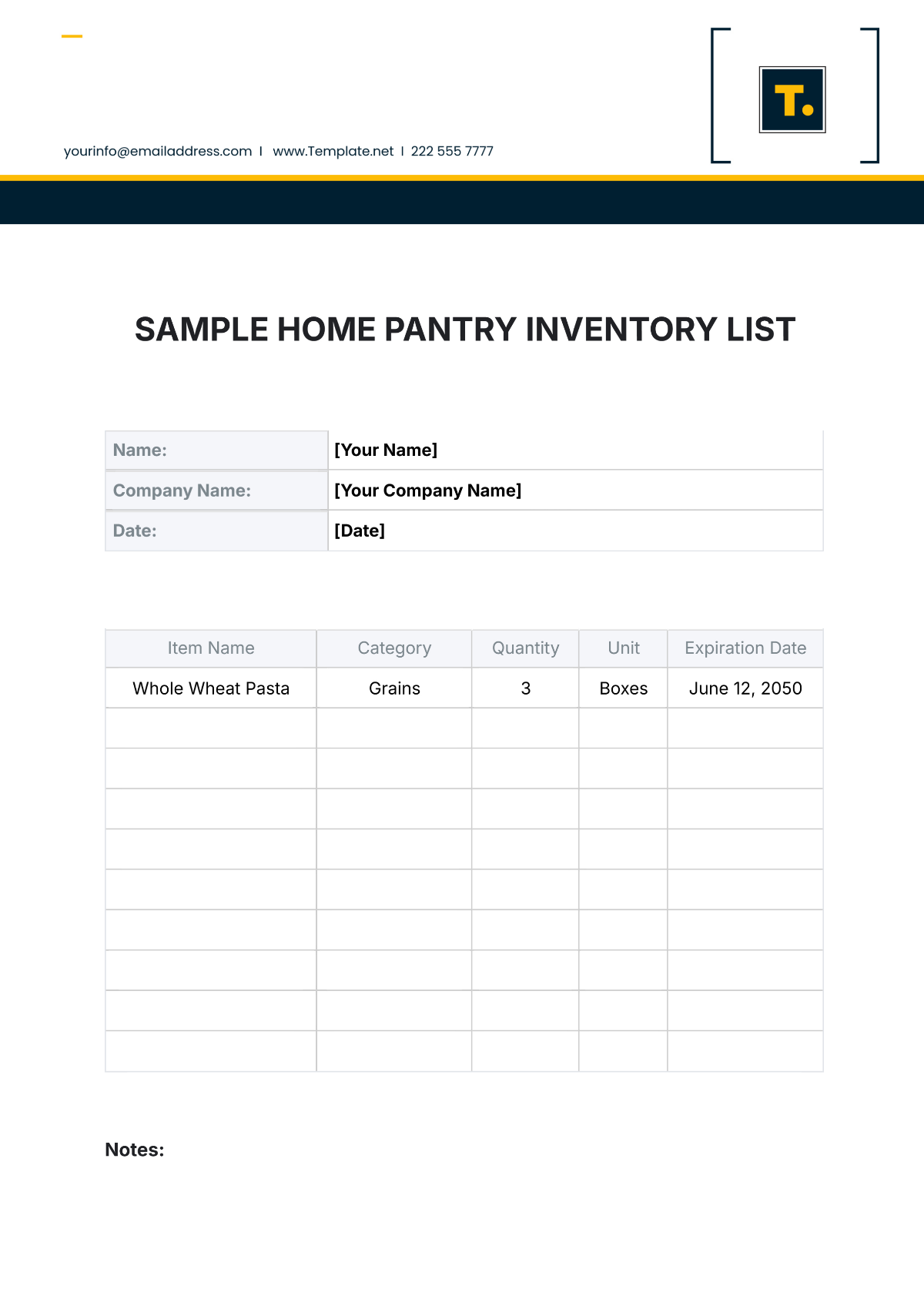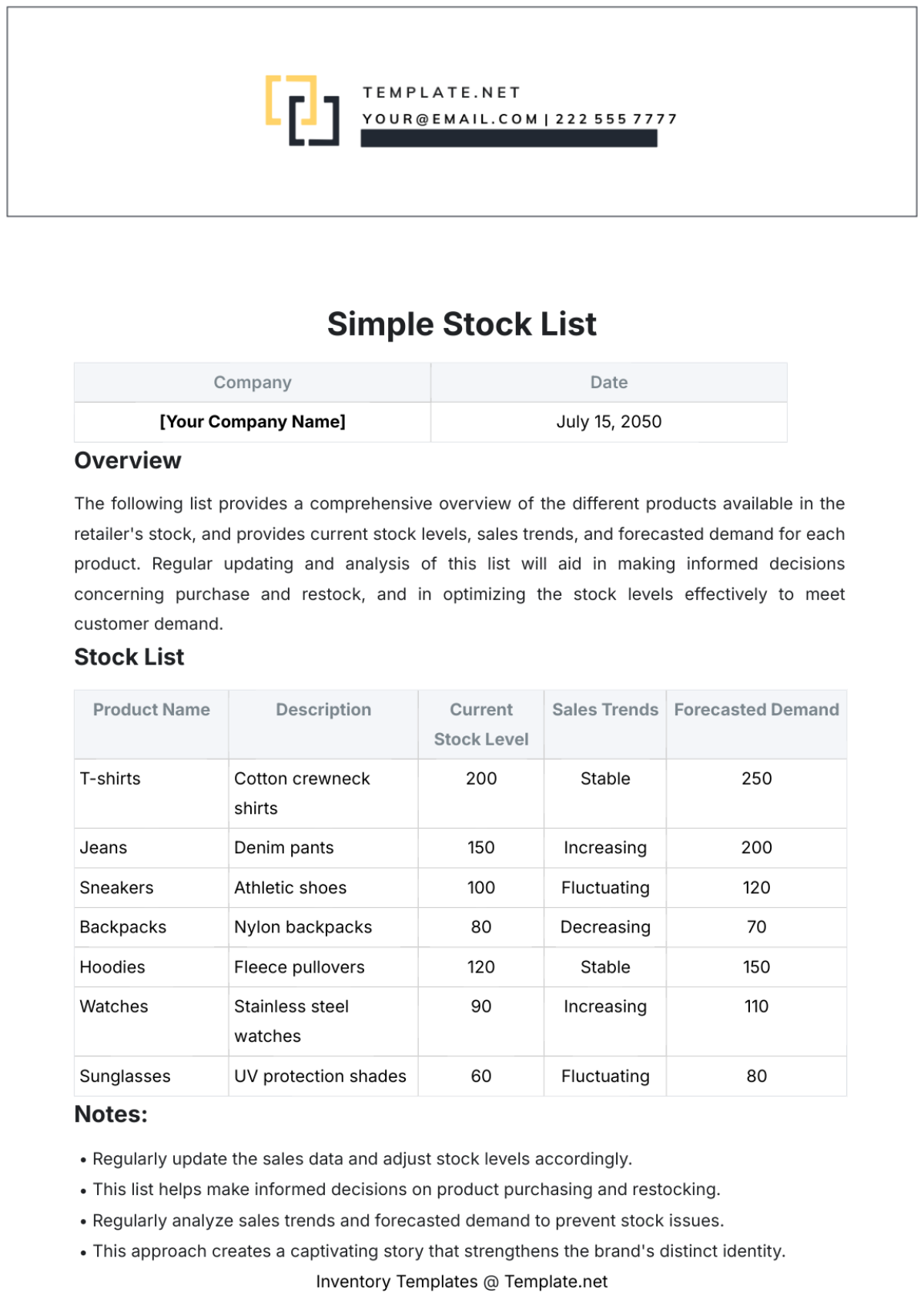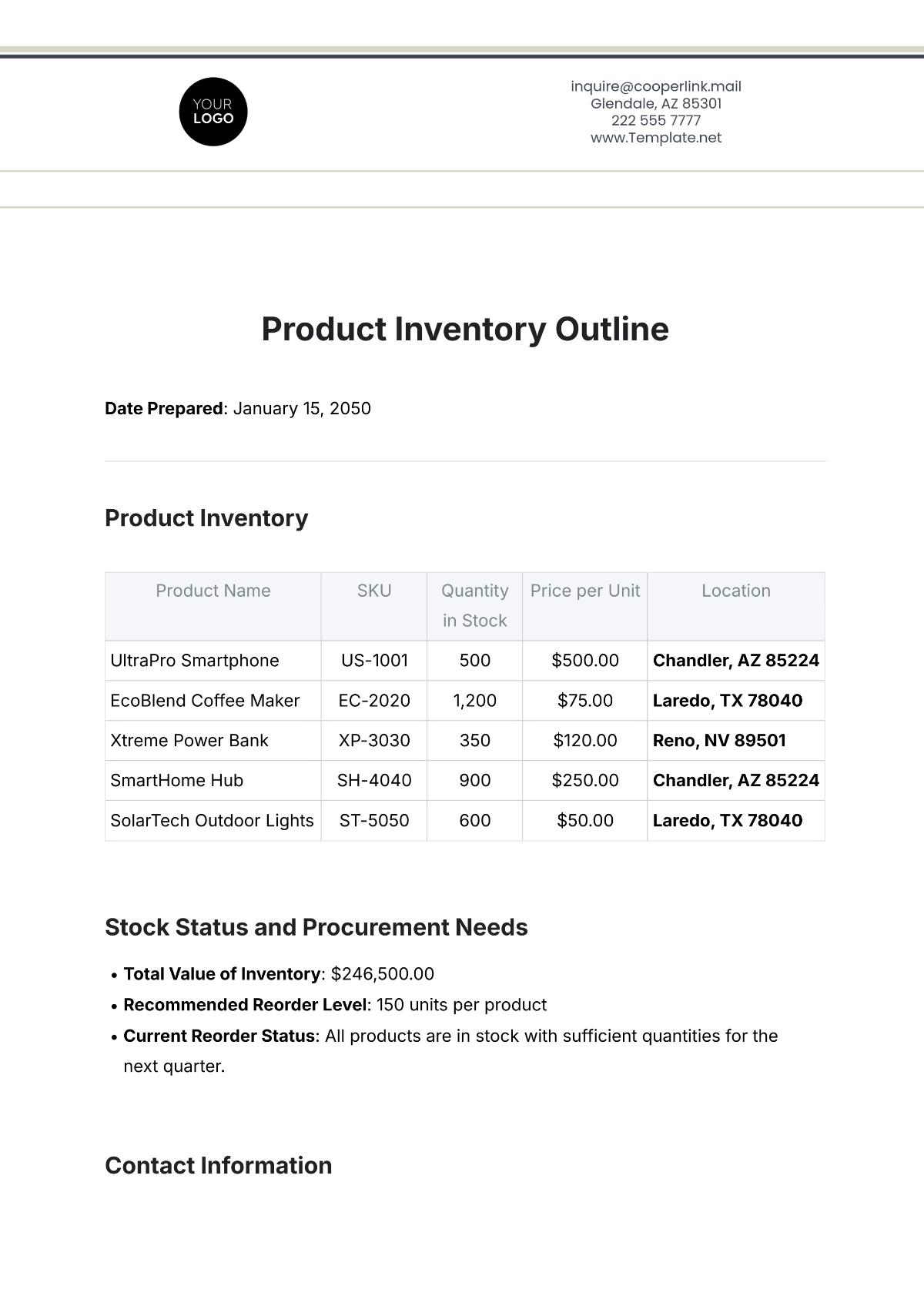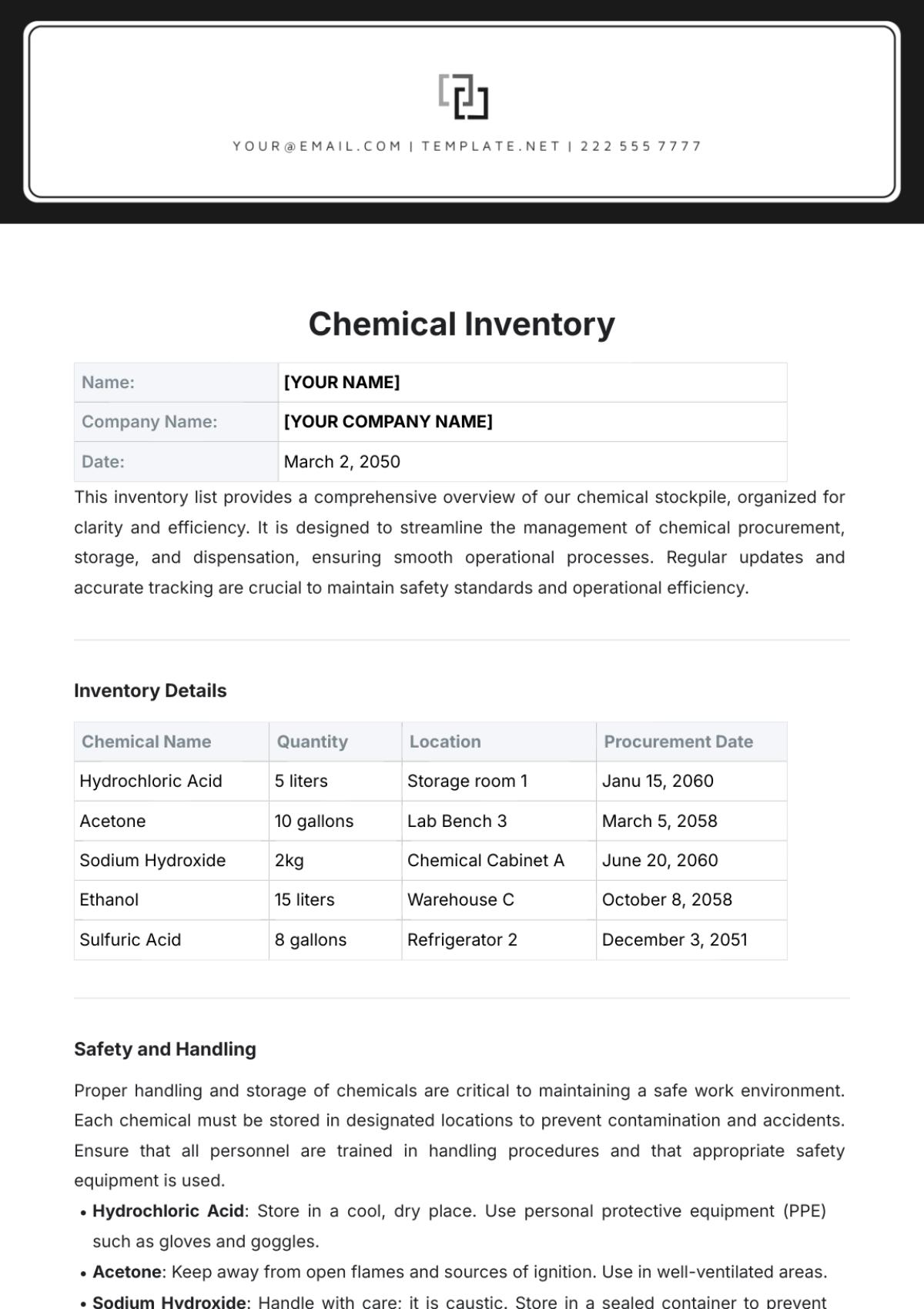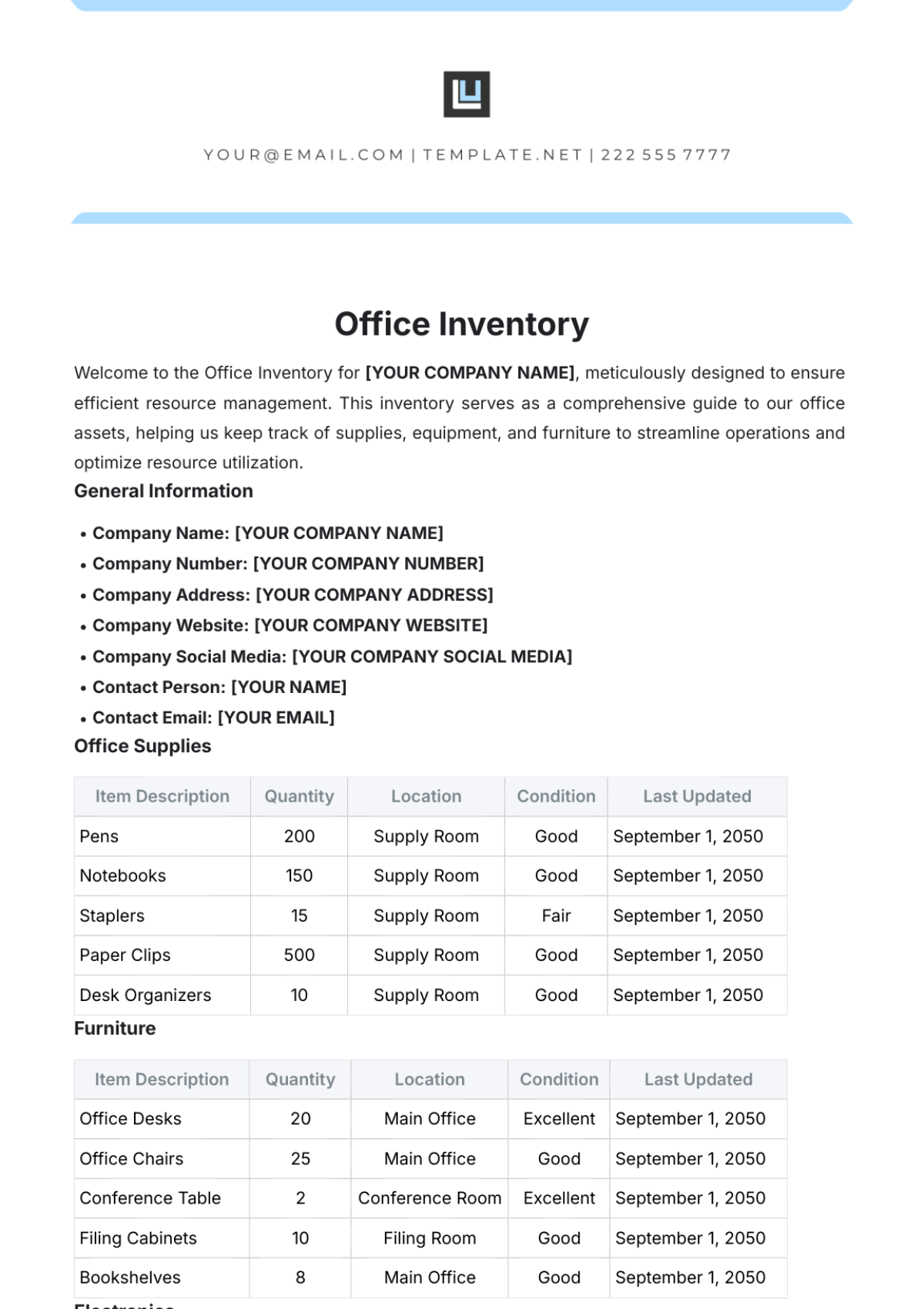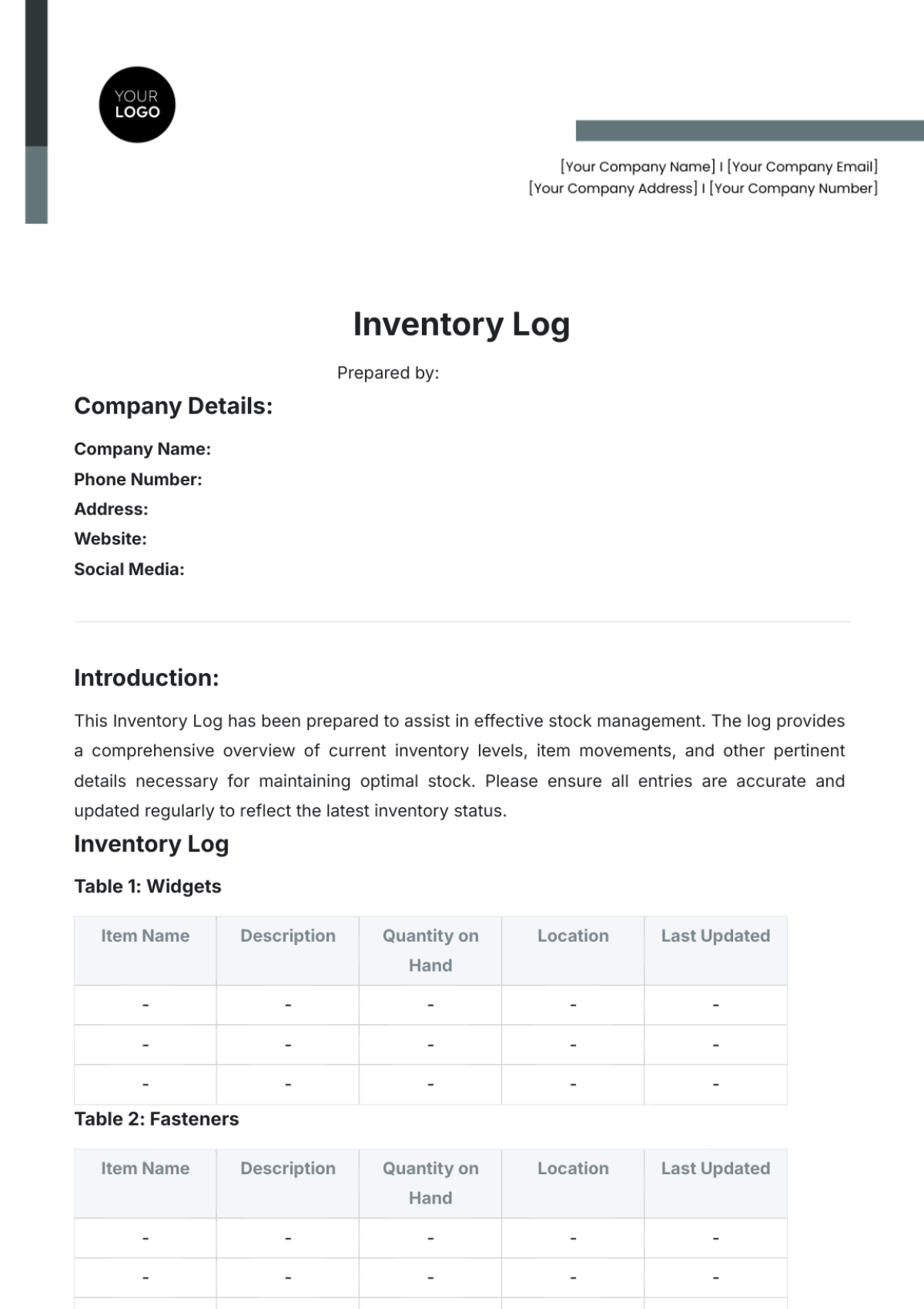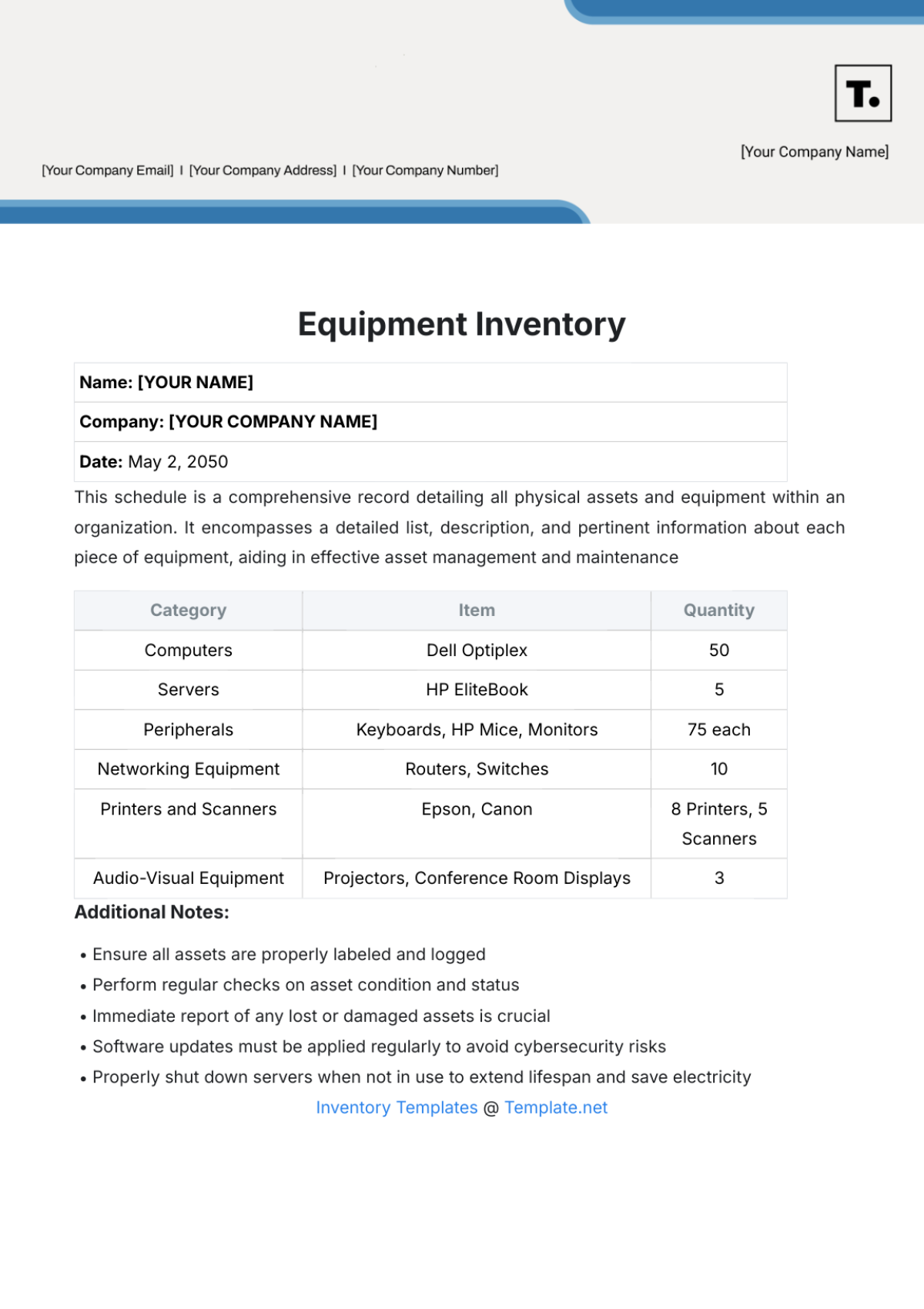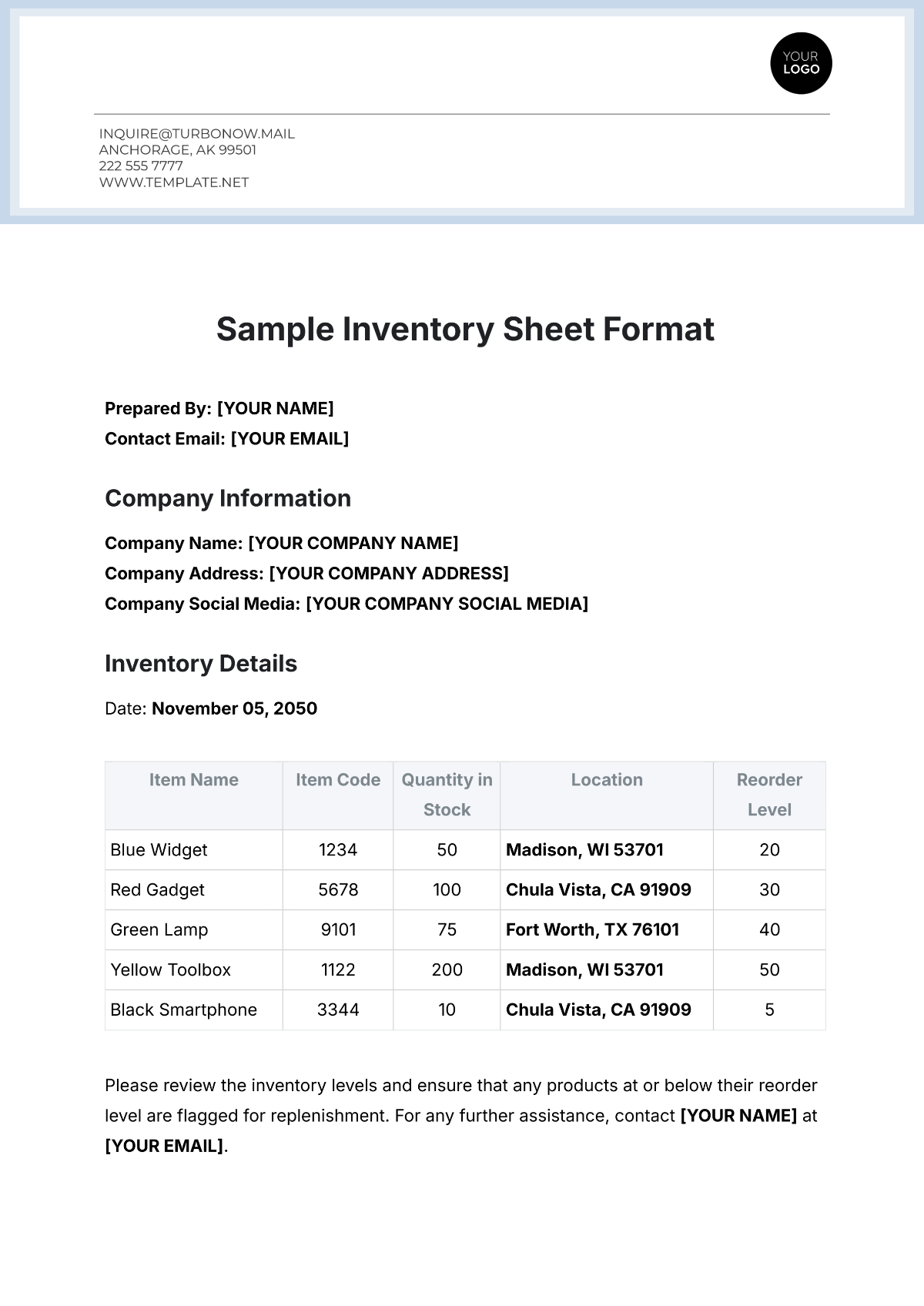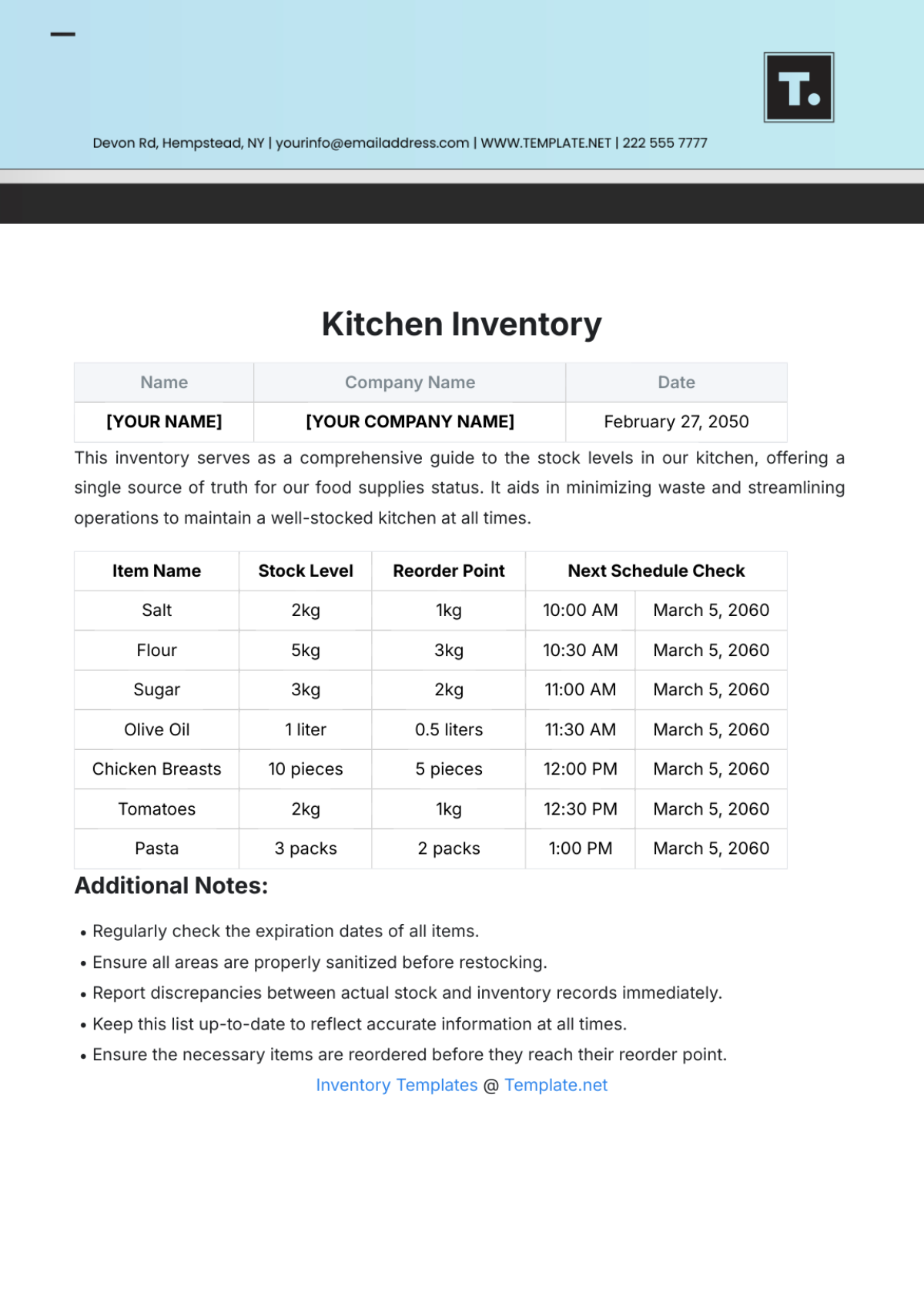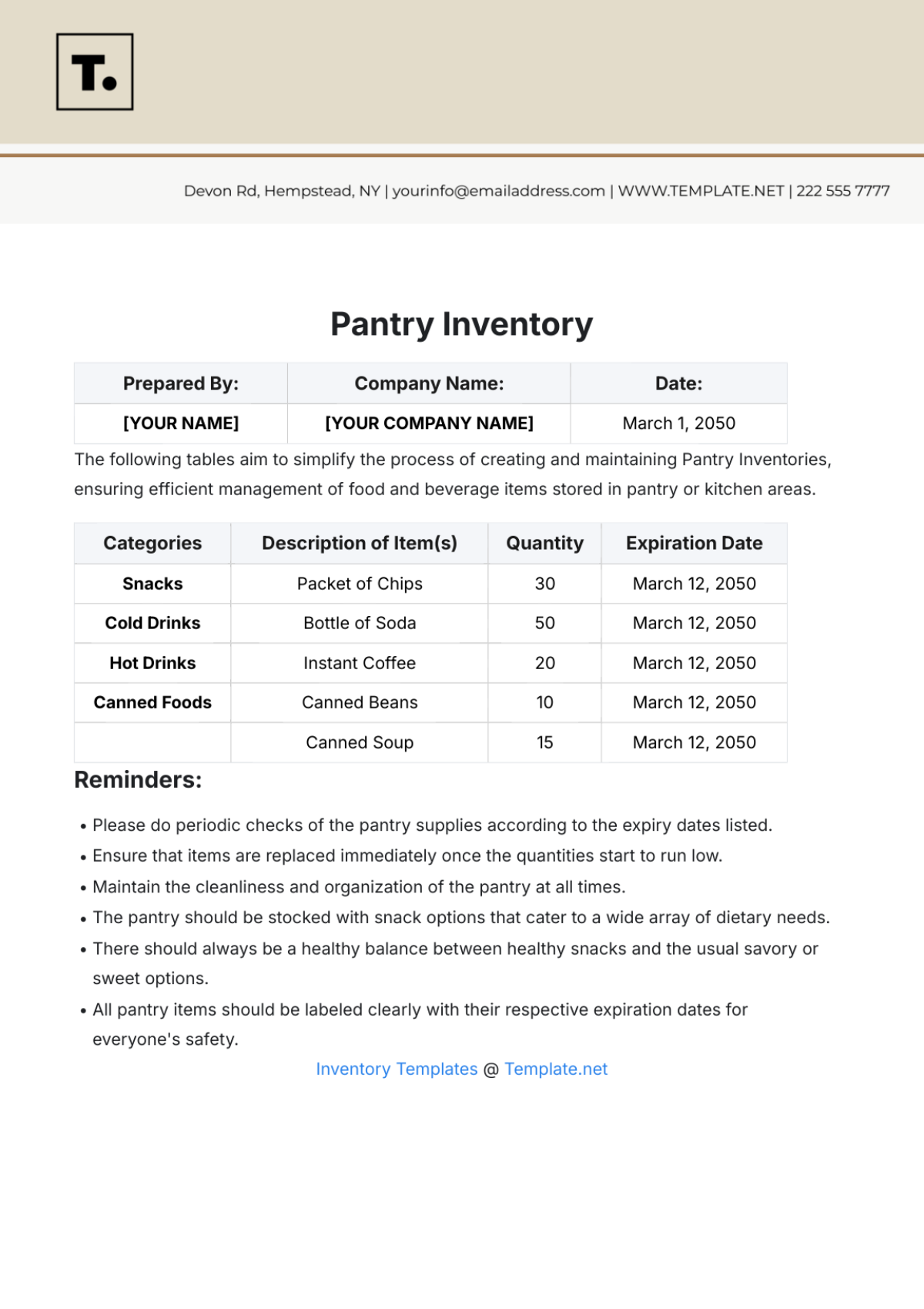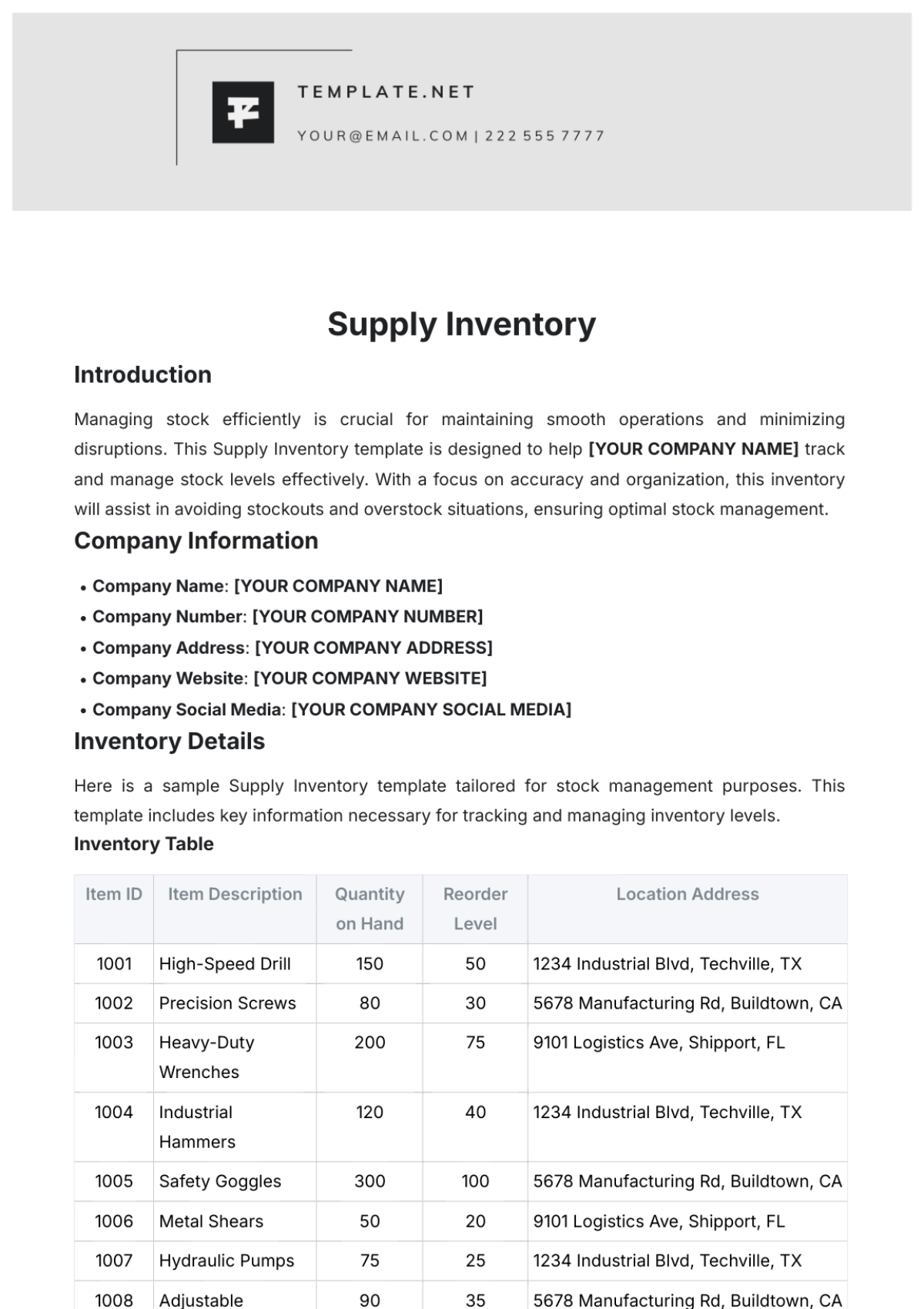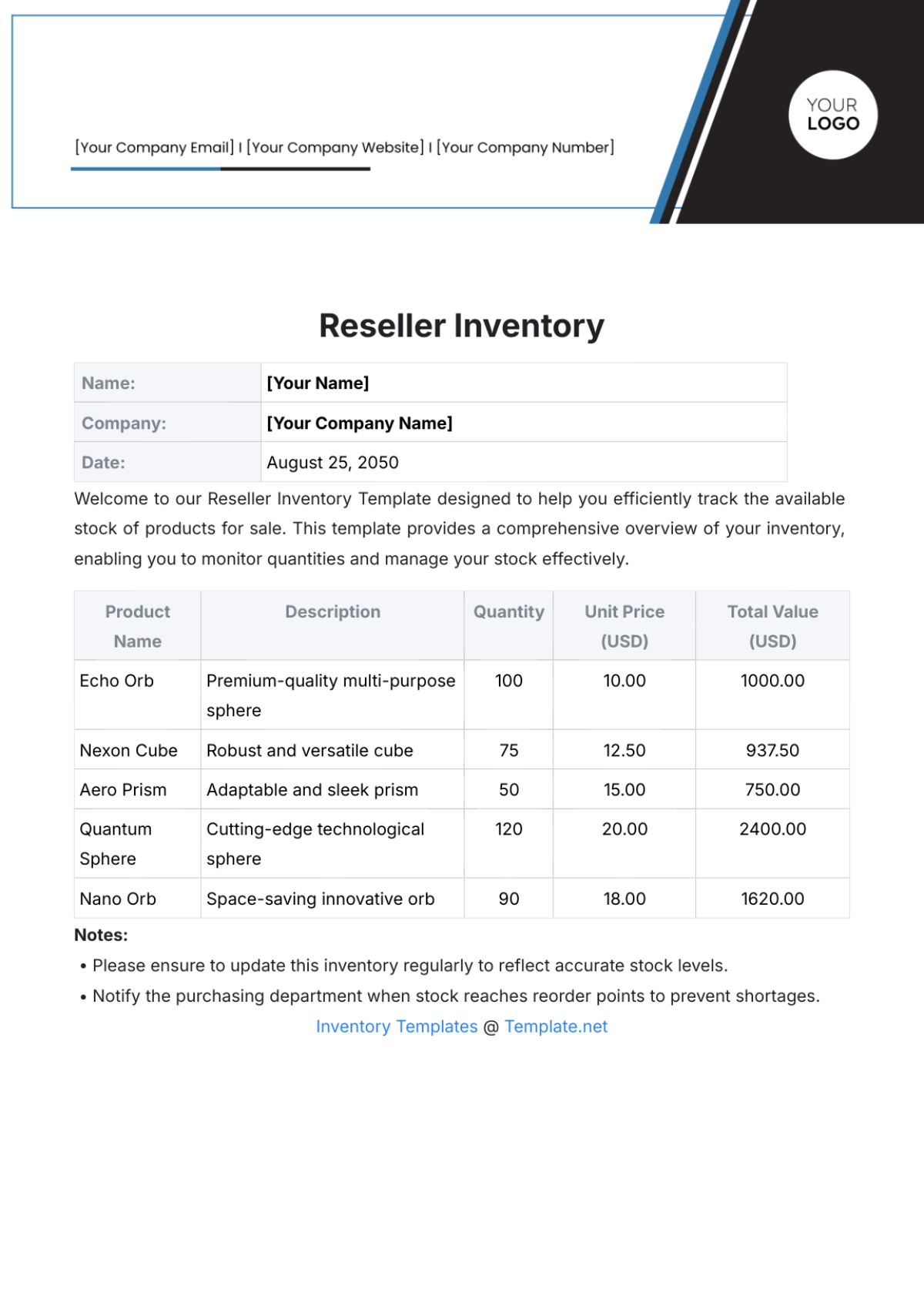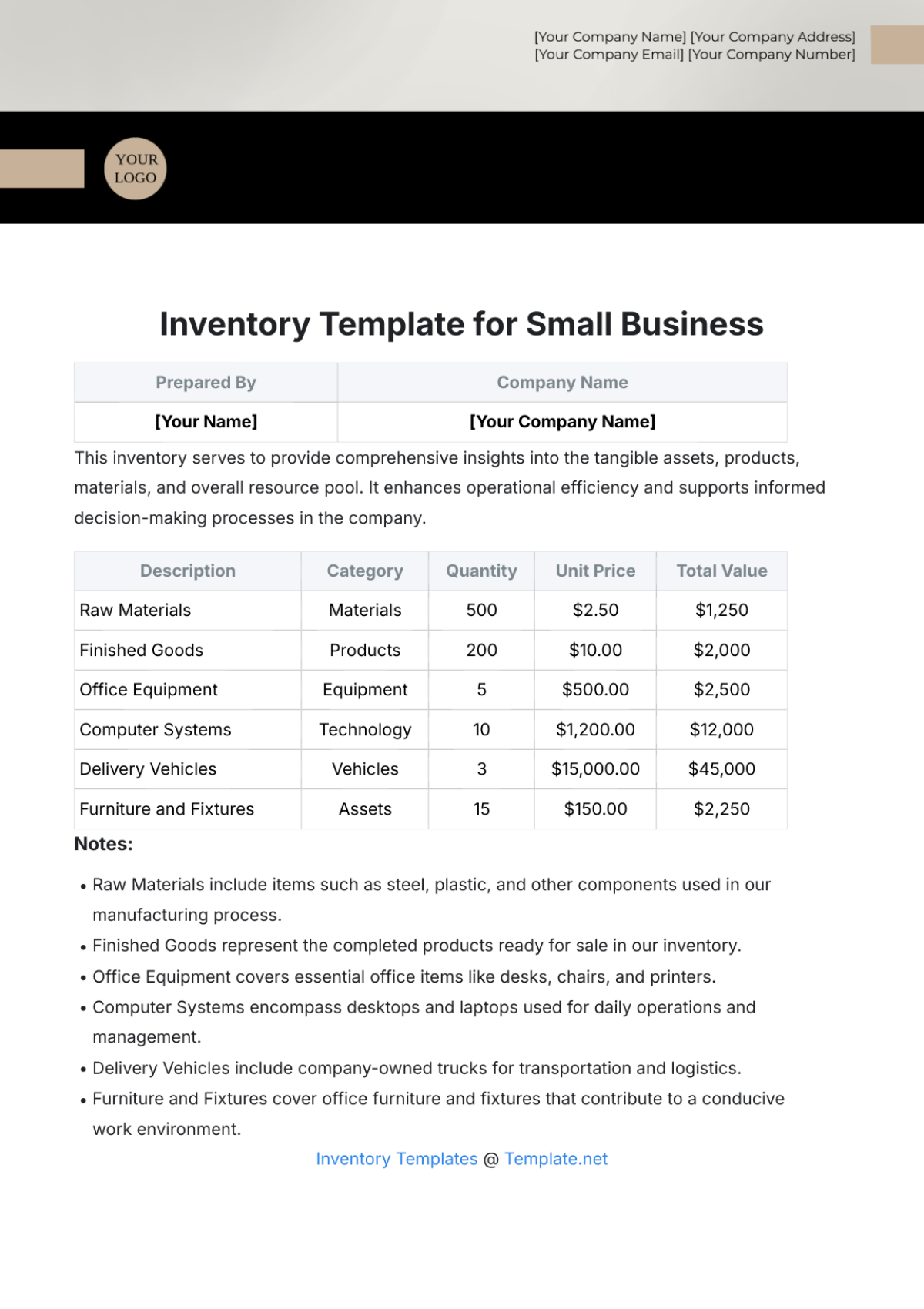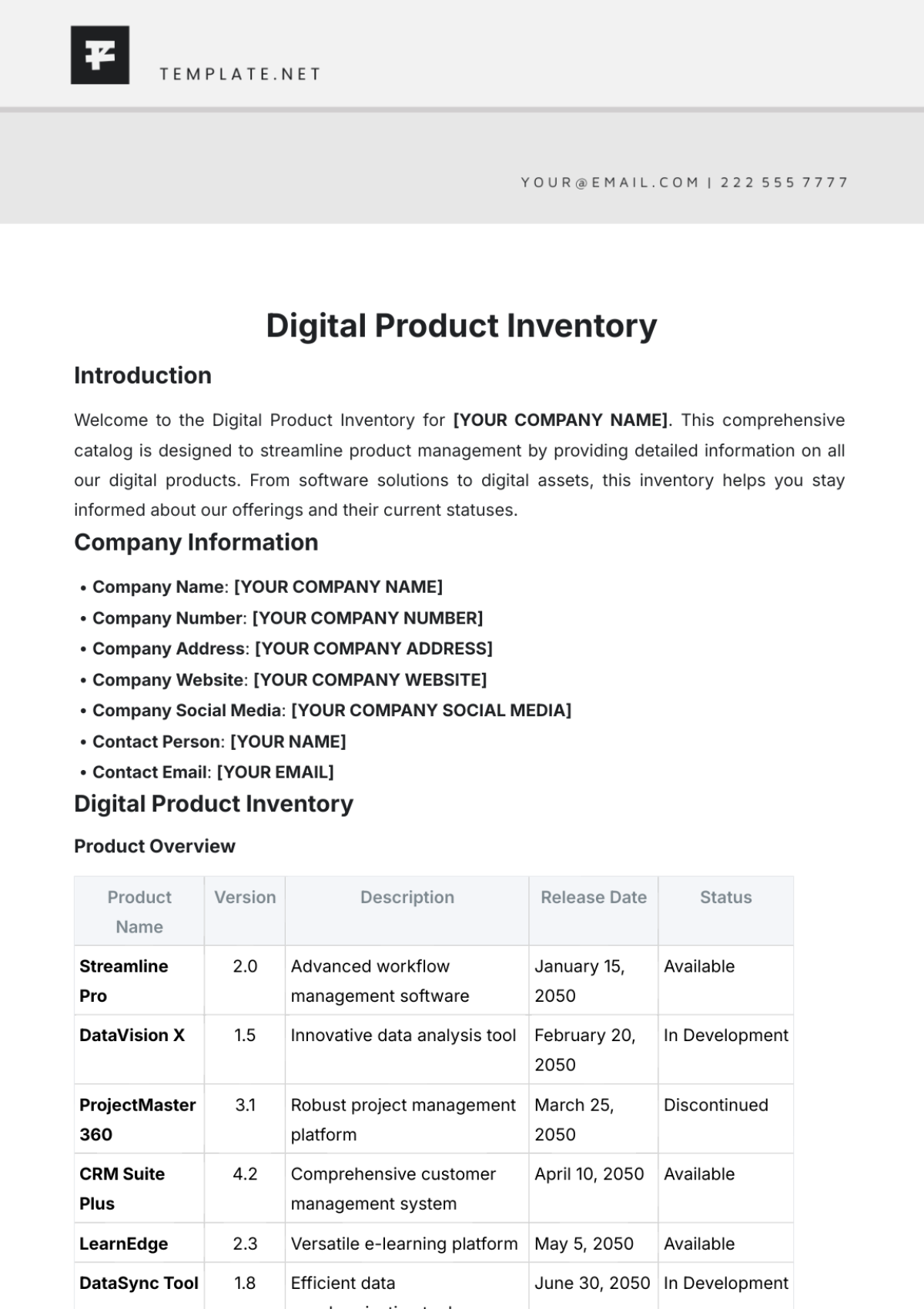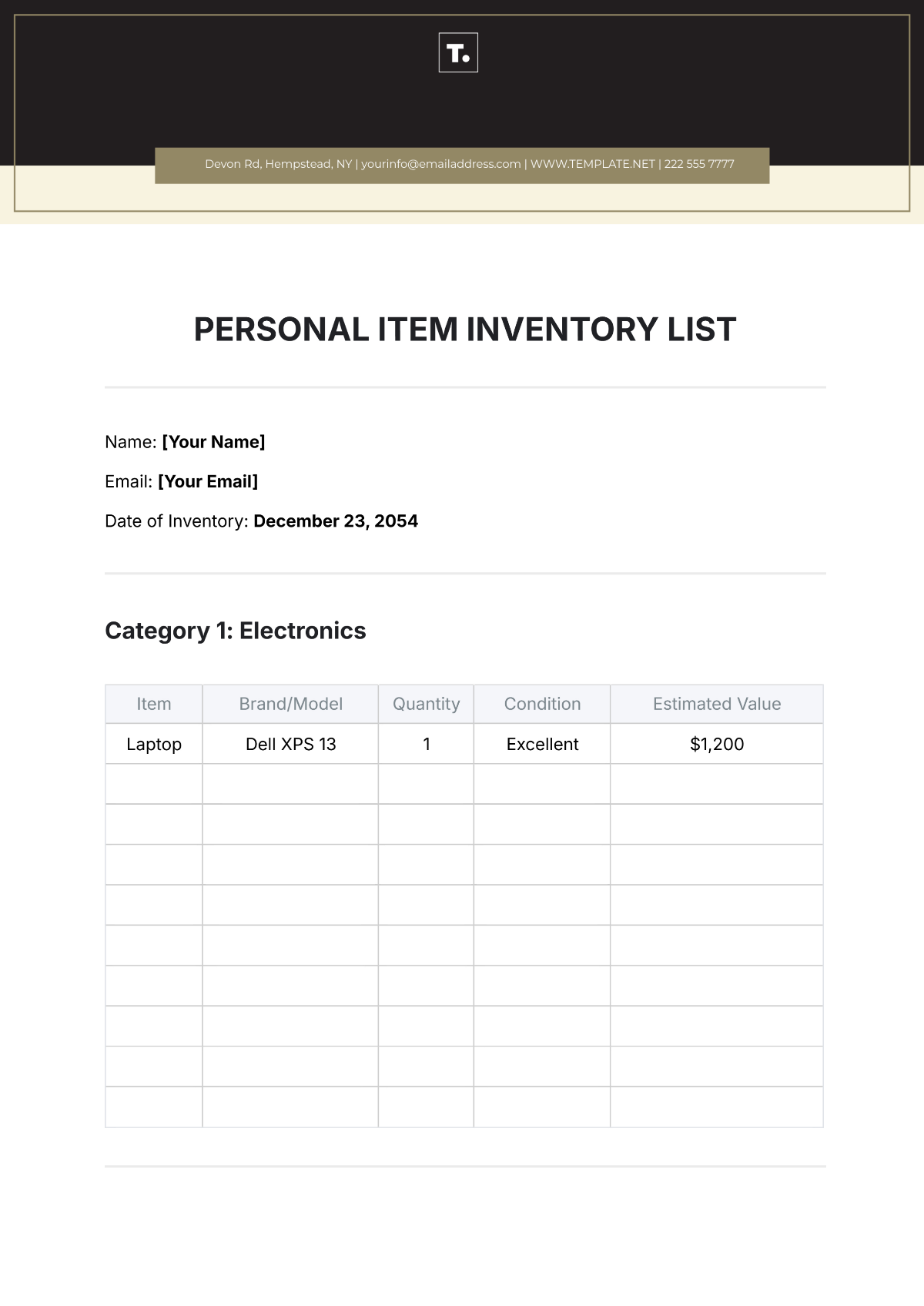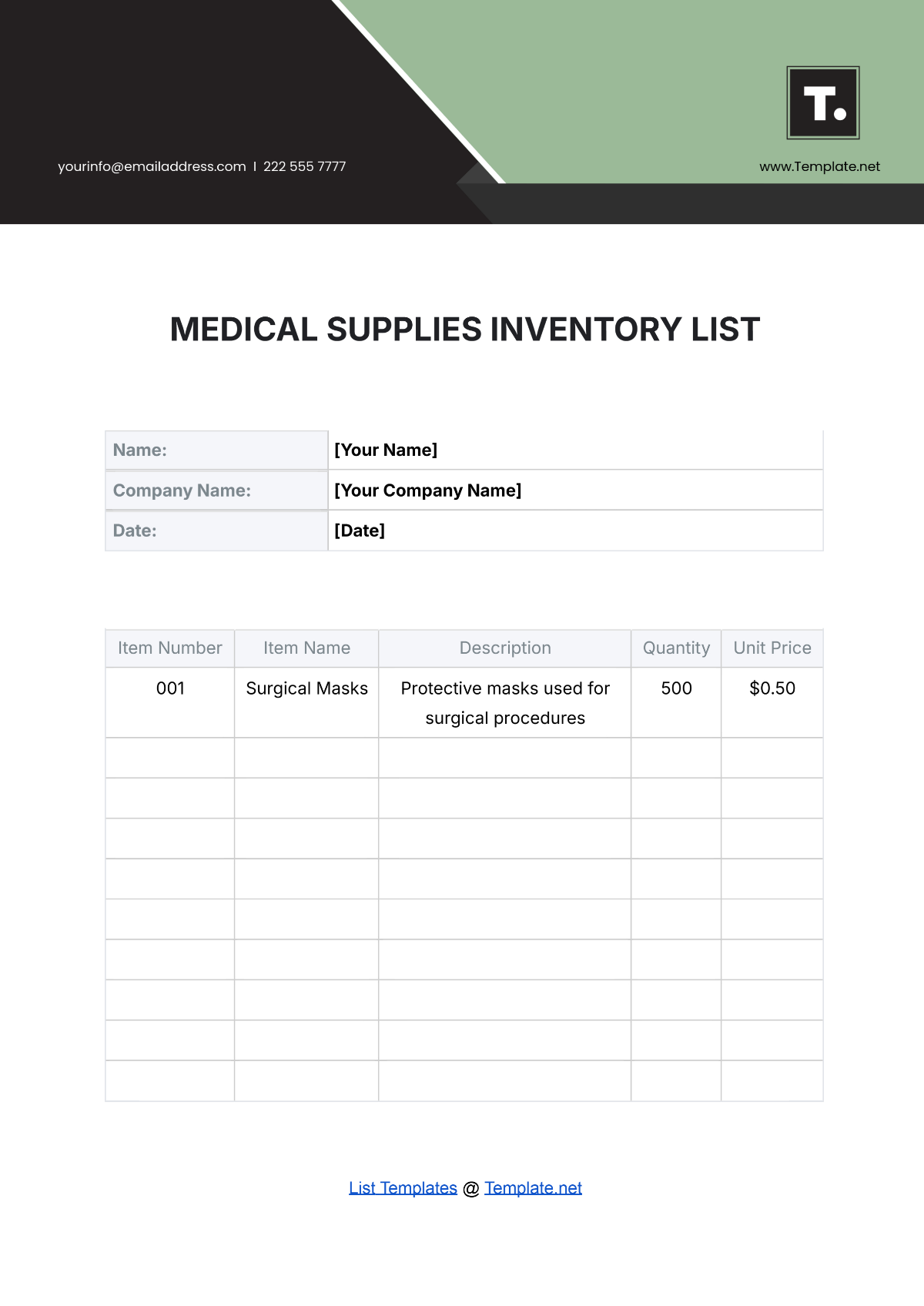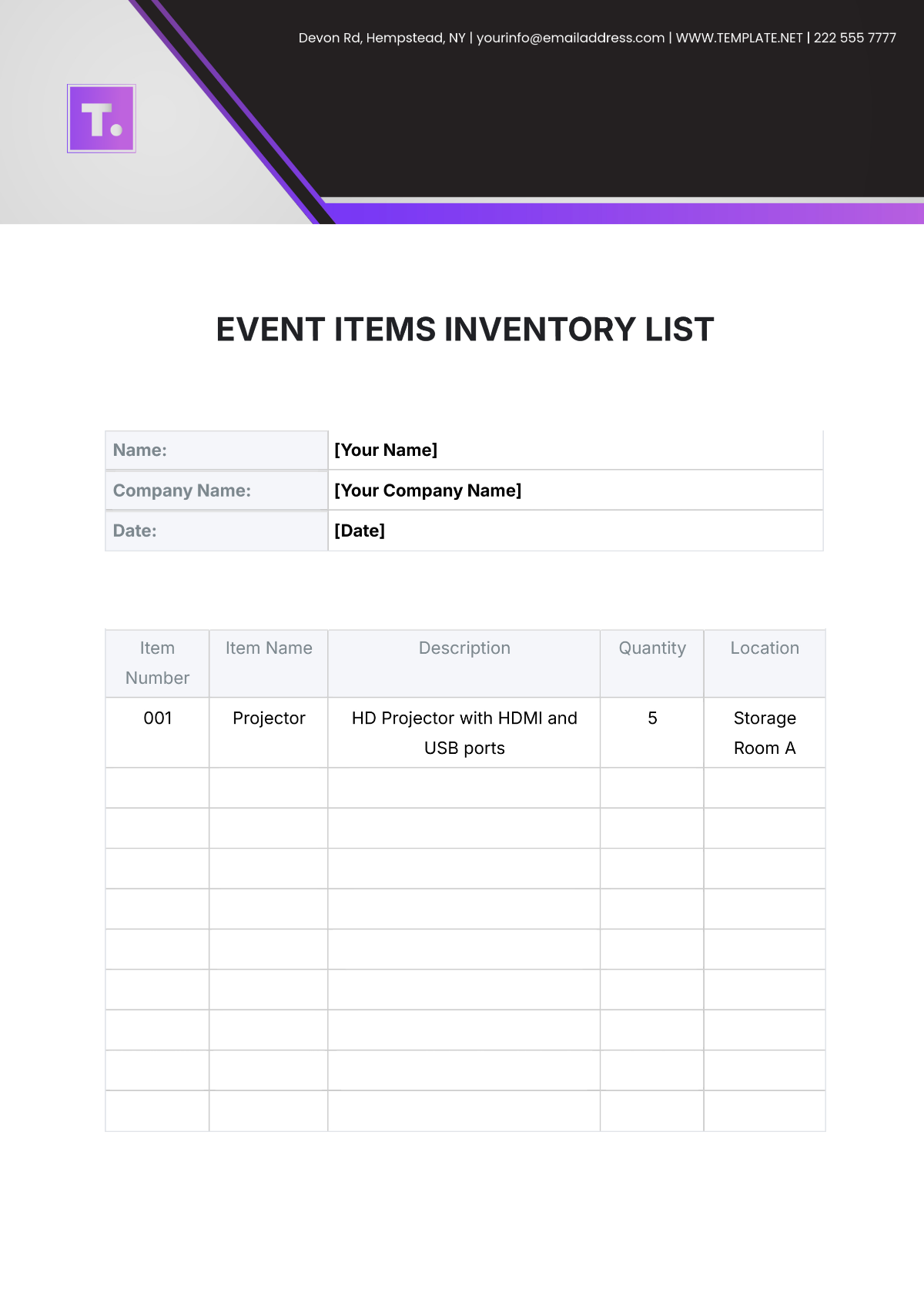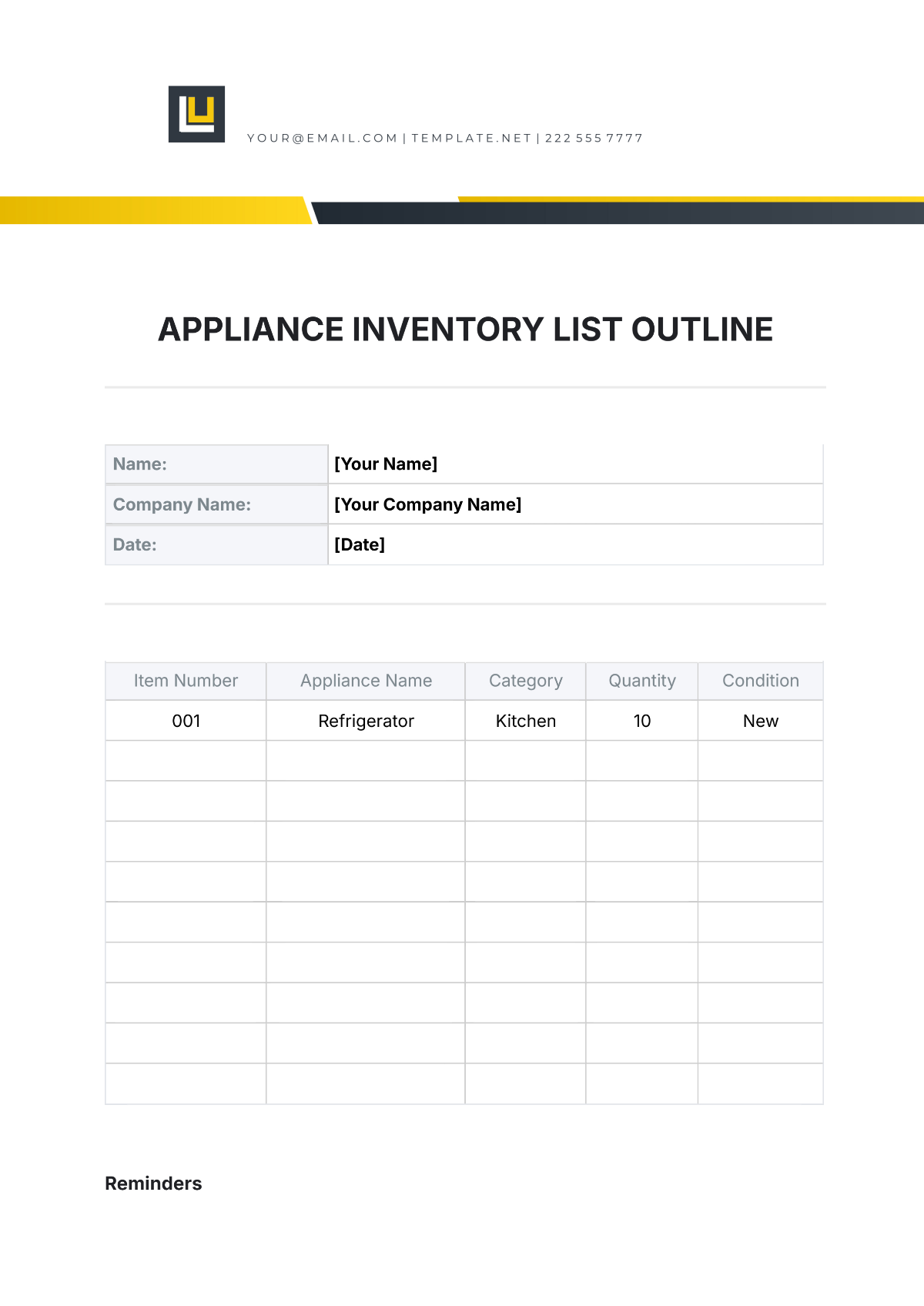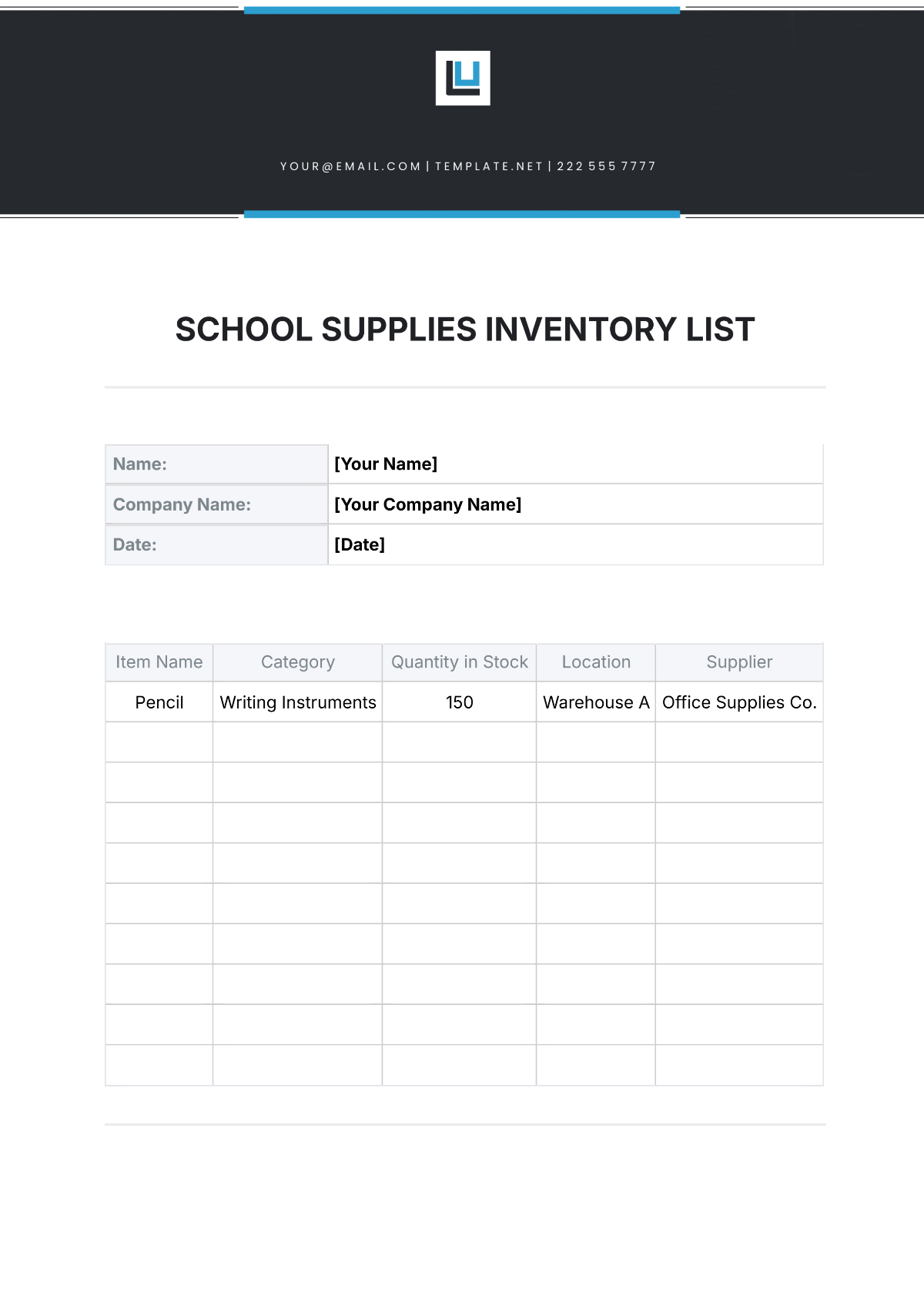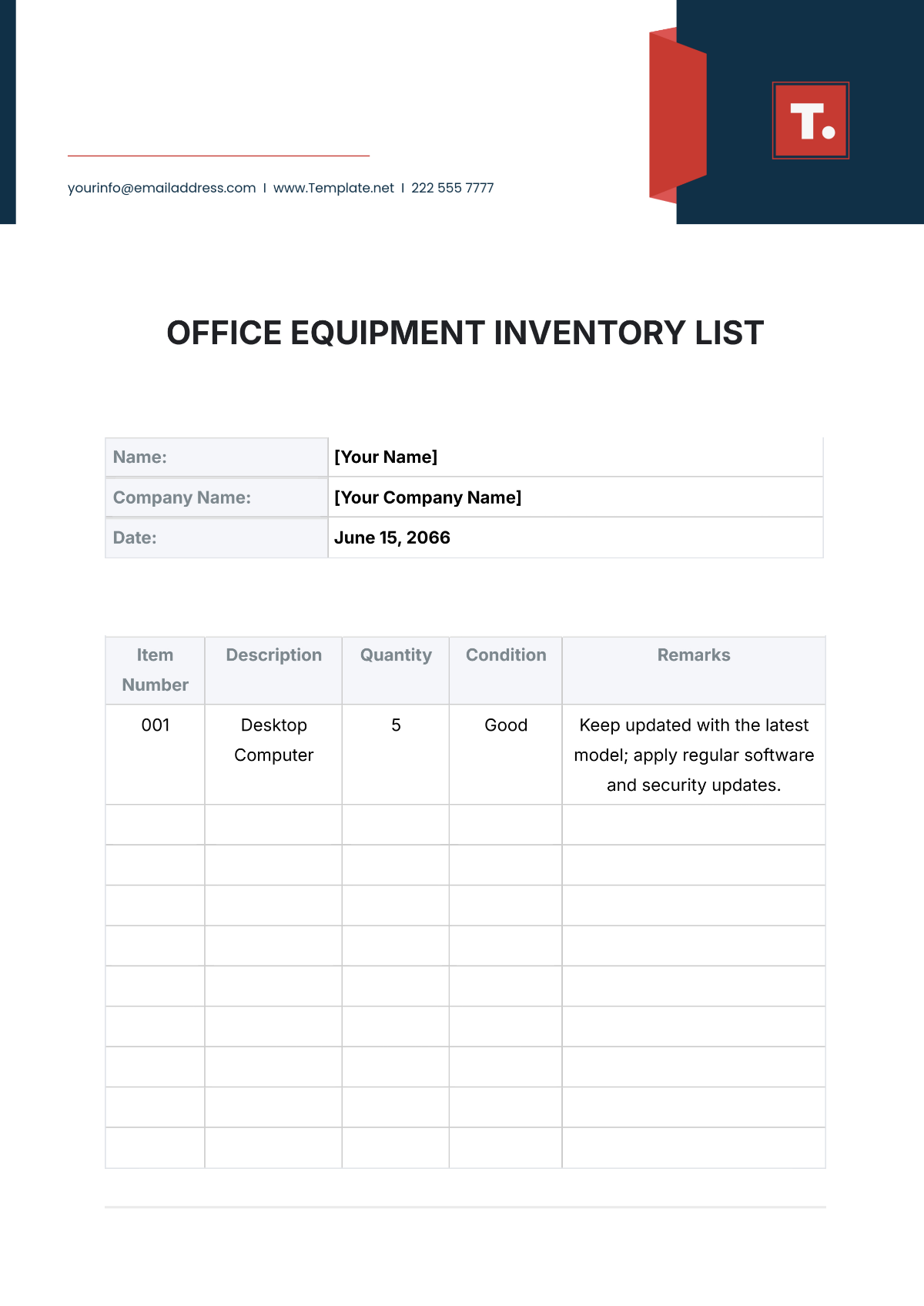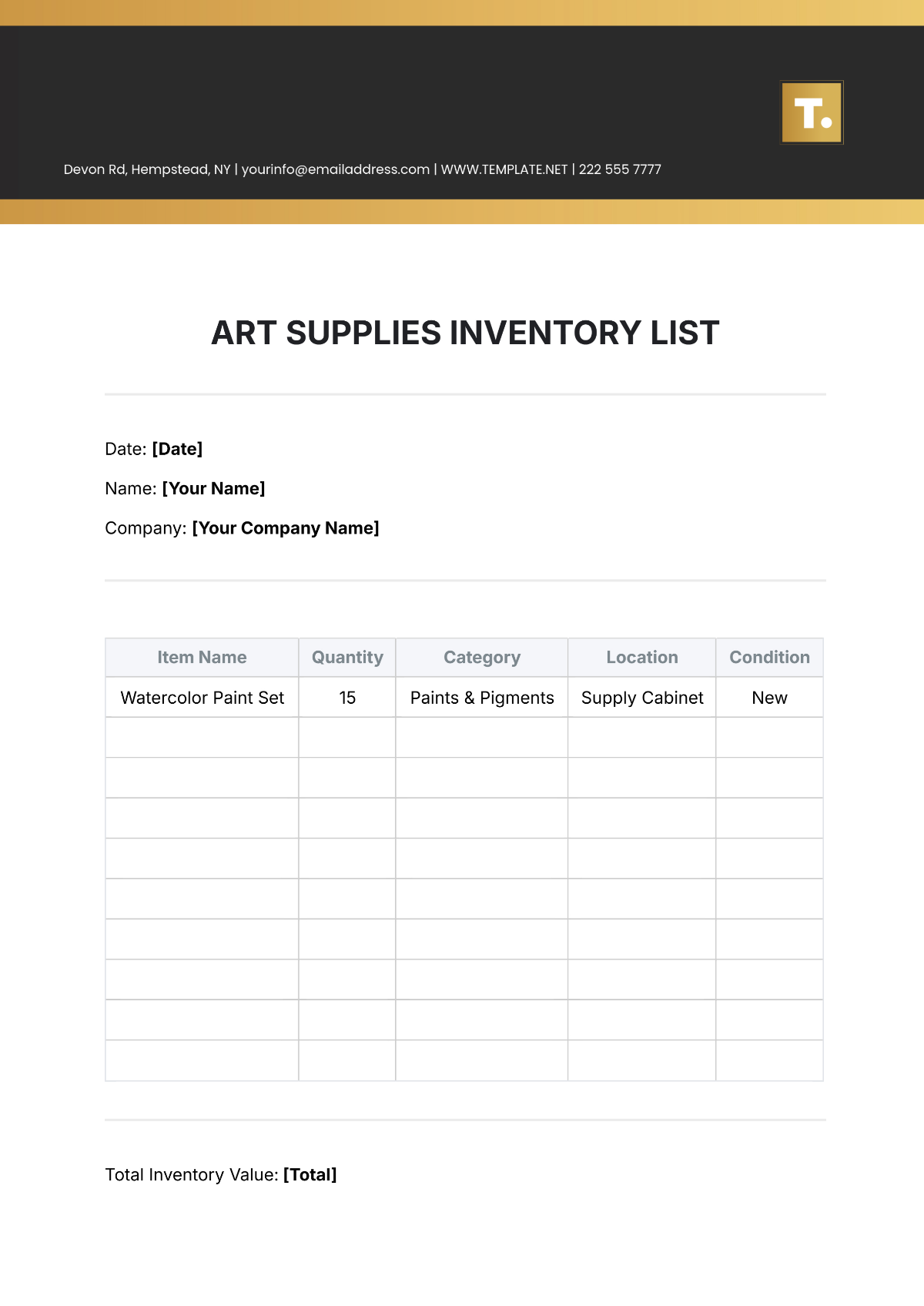Simple Grocery Store Inventory Report
I. Introduction
The purpose of this Grocery Store Inventory Report is to provide a comprehensive overview of the current stock levels, inventory turnover, and any discrepancies within [Your Company Name]. This report will help in making informed decisions regarding restocking, identifying slow-moving items, and optimizing inventory management.
A. Objectives
Monitor Stock Levels: Regularly monitoring stock levels ensures that the store maintains optimal inventory to meet customer demand without overstocking. This helps in minimizing holding costs and maximizing sales.
Identify Discrepancies: Detecting discrepancies between recorded inventory and actual stock levels is crucial for accurate reporting and loss prevention. This helps in identifying issues such as theft, damage, or administrative errors.
Assess Inventory Turnover: Analyzing inventory turnover rates helps in understanding the efficiency of inventory management. High turnover rates indicate strong sales performance and effective inventory control.
B. Methodology
Data Collection: Inventory data was collected through regular stock counts and the use of inventory management software. This includes scanning barcodes, recording stock levels, and updating the system in real-time.
Data Analysis: The collected data was analyzed to identify patterns, trends, and discrepancies. Various metrics such as stock levels, turnover rates, and discrepancies were calculated to provide insights.
II. Stock Levels
The following table presents the current stock levels for major product categories within the store. This includes the quantity on hand, the value of the inventory, and the percentage of total inventory each category represents.
No. | Category | Quantity on Hand | Value | Percentage of Total Inventory |
|---|---|---|---|---|
1 | Fresh Produce | 2,500 | $5,000 | 15% |
2 | Dairy Products | 1,800 | $4,500 | 13% |
3 | Meat and Seafood | 1,200 | $6,000 | 18% |
4 | Packaged Foods | 3,500 | $7,000 | 21% |
5 | Beverages | 2,000 | $3,500 | 10% |
6 | Household Supplies | 1,000 | $2,500 | 7% |
7 | Health and Beauty | 800 | $2,000 | 6% |
8 | Frozen Foods | 1,400 | $3,000 | 9% |
9 | Bakery Items | 600 | $1,500 | 5% |
A. Fresh Produce
Quantity on Hand: There are 2,500 units of fresh produce currently in stock. This category accounts for a significant portion of perishable goods, requiring careful inventory management to minimize spoilage.
Value: The total value of the fresh produce inventory is $5,000. This represents 15% of the total inventory value, indicating its importance in terms of sales and customer demand.
Turnover Rate: Fresh produce typically has a high turnover rate due to its perishable nature. Ensuring timely restocking and reducing waste are key priorities for this category.
Discrepancies: Any discrepancies in this category could indicate spoilage or shrinkage. Regular stock counts and quality checks are essential to maintain accuracy and freshness.
Fresh produce requires frequent monitoring due to its perishable nature. Maintaining accurate records and implementing efficient stock rotation practices are essential to minimize waste and ensure product availability.
B. Dairy Products
Quantity on Hand: There are 1,800 units of dairy products currently in stock. This category includes items such as milk, cheese, and yogurt, which are staples for many customers.
Value: The total value of the dairy products inventory is $4,500, accounting for 13% of the total inventory value. Dairy products are essential for daily consumption, necessitating consistent availability.
Turnover Rate: Dairy products also have a relatively high turnover rate, driven by their perishable nature and constant demand. Efficient stock rotation is crucial to prevent spoilage.
Discrepancies: Discrepancies in dairy products can arise from spoilage, theft, or administrative errors. Implementing stringent stock management practices will help in reducing these issues.
Dairy products also need regular checks and efficient stock rotation due to their perishability. This will help to minimize spoilage and maintain availability for customers.
C. Meat and Seafood
Quantity on Hand: There are 1,200 units of meat and seafood currently in stock. This category includes a variety of fresh and frozen items that require specific storage conditions.
Value: The total value of the meat and seafood inventory is $6,000. This represents 18% of the total inventory value, highlighting its significant contribution to overall sales.
Turnover Rate: Meat and seafood have a high turnover rate due to their perishability and popularity among customers. Regular stock checks and proper storage are critical.
Discrepancies: Discrepancies in this category could indicate spoilage, temperature control issues, or theft. Stringent monitoring and quality checks are essential.
Proper storage and frequent monitoring are crucial for maintaining the quality and safety of meat and seafood products. This helps in reducing losses due to spoilage and ensuring customer satisfaction.
D. Packaged Foods
Quantity on Hand: There are 3,500 units of packaged foods currently in stock. This category includes a wide range of non-perishable items such as snacks, cereals, and canned goods.
Value: The total value of the packaged foods inventory is $7,000, making it the largest category in terms of value and quantity.
Turnover Rate: Packaged foods have a moderate turnover rate, as they have a longer shelf life compared to perishable items. Efficient inventory management ensures timely restocking and optimal stock levels.
Discrepancies: Discrepancies in packaged foods can arise from theft or administrative errors. Regular audits and secure storage practices can help in minimizing these issues.
Packaged foods form a significant part of the inventory and require efficient management to maintain optimal stock levels and prevent losses due to theft or errors.
E. Beverages
Quantity on Hand: There are 2,000 units of beverages currently in stock. This category includes both non-alcoholic and alcoholic drinks.
Value: The total value of the beverages inventory is $3,500, accounting for 10% of the total inventory value.
Turnover Rate: Beverages have a moderate turnover rate, influenced by seasonal demand and promotional activities. Proper inventory management ensures timely restocking.
Discrepancies: Discrepancies in this category can be due to breakages, theft, or administrative errors. Regular stock checks and secure storage can help in reducing these issues.
Beverages require careful monitoring to match supply with seasonal demand and promotional activities, ensuring consistent availability and minimizing losses.
F. Household Supplies
Quantity on Hand: There are 1,000 units of household supplies currently in stock. This category includes cleaning products, paper goods, and other non-food items.
Value: The total value of the household supplies inventory is $2,500, representing 7% of the total inventory value.
Turnover Rate: Household supplies have a steady turnover rate, driven by regular customer demand. Efficient inventory management ensures timely replenishment.
Discrepancies: Discrepancies in household supplies can arise from theft or administrative errors. Implementing secure storage and regular audits can help in minimizing these issues.
Household supplies require consistent monitoring and efficient restocking practices to meet regular customer demand and prevent losses.
G. Health and Beauty
Quantity on Hand: There are 800 units of health and beauty products currently in stock. This category includes personal care items such as shampoos, soaps, and cosmetics.
Value: The total value of the health and beauty inventory is $2,000, accounting for 6% of the total inventory value.
Turnover Rate: Health and beauty products have a moderate turnover rate, influenced by customer preferences and promotional activities. Efficient inventory management ensures optimal stock levels.
Discrepancies: Discrepancies in this category can be due to theft or administrative errors. Regular stock checks and secure storage can help in reducing these issues.
Health and beauty products need careful inventory management to match customer preferences and promotional activities, ensuring consistent availability and minimizing losses.
H. Frozen Foods
Quantity on Hand: There are 1,400 units of frozen foods currently in stock. This category includes items such as frozen vegetables, meats, and ready-to-eat meals.
Value: The total value of the frozen foods inventory is $3,000, representing 9% of the total inventory value.
Turnover Rate: Frozen foods have a moderate turnover rate, driven by their longer shelf life and consistent demand. Proper storage and inventory management are crucial.
Discrepancies: Discrepancies in this category can arise from temperature control issues, theft, or administrative errors. Regular stock checks and quality controls are essential.
Frozen foods require efficient storage and regular quality checks to maintain product integrity and minimize losses due to spoilage or theft.
I. Bakery Items
Quantity on Hand: There are 600 units of bakery items currently in stock. This category includes freshly baked bread, pastries, and cakes.
Value: The total value of the bakery items inventory is $1,500, accounting for 5% of the total inventory value.
Turnover Rate: Bakery items have a high turnover rate due to their perishable nature and daily production. Efficient inventory management ensures timely restocking and reduces waste.
Discrepancies: Discrepancies in this category can be due to spoilage, theft, or administrative errors. Implementing stringent stock management and quality controls can help in minimizing these issues.
Bakery items require daily monitoring and efficient inventory management to maintain freshness, reduce waste, and ensure consistent availability for customers.
III. Inventory Turnover
The following table illustrates the inventory turnover rates for each product category over the past quarter. This metric helps in understanding the efficiency of inventory management and sales performance.
No. | Category | Beginning Inventory | Ending Inventory | Sales (Units) | Turnover Rate |
|---|---|---|---|---|---|
1 | Fresh Produce | 2,000 | 2,500 | 4,500 | 2.25 |
2 | Dairy Products | 1,500 | 1,800 | 3,200 | 2.13 |
3 | Meat and Seafood | 1,000 | 1,200 | 2,800 | 2.33 |
4 | Packaged Foods | 3,000 | 3,500 | 6,000 | 2.00 |
5 | Beverages | 1,500 | 2,000 | 2,500 | 1.67 |
6 | Household Supplies | 800 | 1,000 | 1,800 | 2.25 |
7 | Health and Beauty | 700 | 800 | 1,500 | 2.14 |
8 | Frozen Foods | 1,000 | 1,400 | 2,400 | 2.00 |
9 | Bakery Items | 400 | 600 | 1,200 | 2.00 |
A. Fresh Produce
The turnover rate for fresh produce is 2.25, indicating that the inventory is cycled through 2.25 times during the quarter. This high turnover rate reflects the perishable nature of the products and the consistent demand from customers. Efficient stock rotation and regular restocking are crucial to maintain freshness and minimize waste.
Fresh produce has shown strong sales performance, necessitating timely restocking to meet customer demand. Regular quality checks are essential to ensure that the produce remains fresh and appealing to customers.
B. Dairy Products
Dairy products have a turnover rate of 2.13, showing that the inventory is replenished slightly over two times during the quarter. This rate is indicative of the consistent demand for dairy items and the necessity for efficient inventory management to prevent spoilage.
The steady turnover rate for dairy products emphasizes the need for regular stock rotation and timely replenishment. This helps in maintaining product quality and availability for customers.
C. Meat and Seafood
The turnover rate for meat and seafood is 2.33, highlighting the high demand and quick movement of these products. Efficient storage and regular restocking are vital to maintaining product quality and safety.
The high turnover rate for meat and seafood underscores the importance of stringent quality controls and efficient inventory management. This ensures that customers receive fresh and safe products, enhancing their shopping experience.
D. Packaged Foods
Packaged foods have a turnover rate of 2.00, indicating that the inventory is cycled through twice during the quarter. This moderate turnover rate reflects the longer shelf life of packaged items and the consistent demand.
The steady turnover rate for packaged foods suggests the need for efficient stock management to ensure timely replenishment and prevent overstocking. This helps in maintaining optimal inventory levels and minimizing holding costs.
E. Beverages
The turnover rate for beverages is 1.67, showing a slower movement compared to other categories. This rate may be influenced by seasonal demand and promotional activities. Proper inventory management ensures timely restocking and optimal stock levels.
The lower turnover rate for beverages highlights the need for careful monitoring of inventory levels and seasonal demand patterns. This helps in maintaining consistent availability and minimizing losses due to overstocking.
F. Household Supplies
Household supplies have a turnover rate of 2.25, indicating strong sales performance and efficient inventory management. Regular audits and secure storage practices help in maintaining accurate stock levels.
The high turnover rate for household supplies emphasizes the need for timely restocking and efficient inventory management. This ensures that customers have access to essential items, enhancing their shopping experience.
G. Health and Beauty
The turnover rate for health and beauty products is 2.14, reflecting steady sales and consistent demand. Efficient inventory management ensures optimal stock levels and minimizes losses due to theft or administrative errors.
The steady turnover rate for health and beauty products suggests the need for regular stock checks and secure storage practices. This helps in maintaining product availability and preventing losses.
H. Frozen Foods
Frozen foods have a turnover rate of 2.00, indicating steady sales and consistent demand. Proper storage and inventory management are crucial to maintaining product integrity and availability.
The moderate turnover rate for frozen foods highlights the need for efficient storage and regular quality checks. This ensures that customers receive high-quality products, enhancing their shopping experience.
I. Bakery Items
Bakery items have a turnover rate of 2.00, reflecting the high demand and quick movement of these products. Efficient inventory management and regular restocking are essential to maintain freshness and prevent waste.
The high turnover rate for bakery items underscores the importance of daily monitoring and efficient stock rotation. This helps in maintaining product freshness and availability for customers.
The analysis of inventory turnover rates highlights the efficiency of inventory management practices within [Your Company Name]. Categories such as fresh produce, dairy products, and meat and seafood show high turnover rates, indicating strong sales performance and effective stock management.
IV. Inventory Discrepancies
The following table presents the discrepancies observed in the inventory for each product category over the past quarter. Discrepancies are calculated by comparing the recorded inventory with the actual stock levels.
No. | Category | Recorded Inventory | Actual Inventory | Discrepancy (Units) | Discrepancy |
|---|---|---|---|---|---|
1 | Fresh Produce | 2,500 | 2,400 | -100 | -4% |
2 | Dairy Products | 1,800 | 1,750 | -50 | -2.78% |
3 | Meat and Seafood | 1,200 | 1,150 | -50 | -4.17% |
4 | Packaged Foods | 3,500 | 3,450 | -50 | -1.43% |
5 | Beverages | 2,000 | 1,950 | -50 | -2.50% |
6 | Household Supplies | 1,000 | 990 | -10 | -1% |
7 | Health and Beauty | 800 | 780 | -20 | -2.5% |
8 | Frozen Foods | 1,400 | 1,350 | -50 | -3.57% |
9 | Bakery Items | 600 | 590 | -10 | -1.67% |
A. Fresh Produce
Recorded Inventory: The recorded inventory for fresh produce was 2,500 units. This category often experiences discrepancies due to its perishable nature.
Actual Inventory: The actual inventory count revealed 2,400 units, indicating a discrepancy of -100 units or -4%.
Possible Causes: Discrepancies in fresh produce can result from spoilage, shrinkage, or errors in recording stock levels. Regular quality checks and accurate recording practices are essential.
Impact: The discrepancy of -4% highlights the need for improved inventory management practices to reduce spoilage and maintain accurate stock levels.
Regular monitoring and accurate recording practices can help in reducing discrepancies in fresh produce, ensuring that the inventory remains fresh and meets customer demand.
B. Dairy Products
Recorded Inventory: The recorded inventory for dairy products was 1,800 units. Discrepancies in this category can arise due to spoilage or theft.
Actual Inventory: The actual inventory count showed 1,750 units, resulting in a discrepancy of -50 units or -2.78%.
Possible Causes: Discrepancies in dairy products can be due to spoilage, theft, or administrative errors. Implementing stringent stock management practices can help in minimizing these issues.
Impact: The discrepancy of -2.78% emphasizes the need for regular stock checks and efficient inventory management to prevent losses.
Efficient inventory management and regular stock checks are essential to maintain accurate stock levels and minimize discrepancies in dairy products.
C. Meat and Seafood
Recorded Inventory: The recorded inventory for meat and seafood was 1,200 units. Discrepancies in this category can be due to spoilage, theft, or temperature control issues.
Actual Inventory: The actual inventory count revealed 1,150 units, indicating a discrepancy of -50 units or -4.17%.
Possible Causes: Discrepancies in meat and seafood can result from spoilage, temperature control issues, or administrative errors. Regular quality checks and efficient inventory management are crucial.
Impact: The discrepancy of -4.17% highlights the importance of maintaining proper storage conditions and accurate recording practices to reduce losses.
Maintaining proper storage conditions and regular quality checks can help in minimizing discrepancies and ensuring product quality in meat and seafood.
D. Packaged Foods
Recorded Inventory: The recorded inventory for packaged foods was 3,500 units. Discrepancies in this category can arise from theft or administrative errors.
Actual Inventory: The actual inventory count showed 3,450 units, resulting in a discrepancy of -50 units or -1.43%.
Possible Causes: Discrepancies in packaged foods can be due to theft or errors in recording stock levels. Regular audits and secure storage practices can help in minimizing these issues.
Impact: The discrepancy of -1.43% emphasizes the need for accurate recording practices and secure storage to prevent losses.
Regular audits and secure storage practices are essential to maintain accurate stock levels and minimize discrepancies in packaged foods.
E. Beverages
Recorded Inventory: The recorded inventory for beverages was 2,000 units. Discrepancies in this category can arise from breakages, theft, or administrative errors.
Actual Inventory: The actual inventory count revealed 1,950 units, indicating a discrepancy of -50 units or -2.50%.
Possible Causes: Discrepancies in beverages can result from breakages, theft, or errors in recording stock levels. Implementing secure storage and regular audits can help in reducing these issues.
Impact: The discrepancy of -2.50% highlights the need for careful monitoring and secure storage to prevent losses.
Careful monitoring and secure storage practices are crucial to maintaining accurate stock levels and minimizing discrepancies in beverages.
F. Household Supplies
Recorded Inventory: The recorded inventory for household supplies was 1,000 units. Discrepancies in this category can be due to theft or administrative errors.
Actual Inventory: The actual inventory count showed 990 units, resulting in a discrepancy of -10 units or -1%.
Possible Causes: Discrepancies in household supplies can arise from theft or errors in recording stock levels. Regular audits and secure storage practices can help in minimizing these issues.
Impact: The discrepancy of -1% emphasizes the need for accurate recording practices and secure storage to prevent losses.
Regular audits and secure storage practices are essential to maintaining accurate stock levels and minimizing discrepancies in household supplies.
G. Health and Beauty
Recorded Inventory: The recorded inventory for health and beauty products was 800 units. Discrepancies in this category can be due to theft or administrative errors.
Actual Inventory: The actual inventory count revealed 780 units, indicating a discrepancy of -20 units or -2.5%.
Possible Causes: Discrepancies in health and beauty products can arise from theft or errors in recording stock levels. Regular audits and secure storage practices can help in minimizing these issues.
Impact: The discrepancy of -2.5% highlights the need for accurate recording practices and secure storage to prevent losses.
Regular audits and secure storage practices are crucial to maintaining accurate stock levels and minimizing discrepancies in health and beauty products.
H. Frozen Foods
Recorded Inventory: The recorded inventory for frozen foods was 1,400 units. Discrepancies in this category can be due to temperature control issues, theft, or administrative errors.
Actual Inventory: The actual inventory count showed 1,350 units, resulting in a discrepancy of -50 units or -3.57%.
Possible Causes: Discrepancies in frozen foods can arise from temperature control issues, theft, or errors in recording stock levels. Regular quality checks and efficient inventory management are crucial.
Impact: The discrepancy of -3.57% emphasizes the importance of maintaining proper storage conditions and accurate recording practices to reduce losses.
Maintaining proper storage conditions and regular quality checks are essential to minimizing discrepancies and ensuring product quality in frozen foods.
I. Bakery Items
Recorded Inventory: The recorded inventory for bakery items was 600 units. Discrepancies in this category can arise from spoilage, theft, or administrative errors.
Actual Inventory: The actual inventory count revealed 590 units, indicating a discrepancy of -10 units or -1.67%.
Possible Causes: Discrepancies in bakery items can be due to spoilage, theft, or errors in recording stock levels. Implementing stringent stock management and quality controls can help in minimizing these issues.
Impact: The discrepancy of -1.67% highlights the need for regular stock checks and efficient inventory management to maintain freshness and prevent losses.
Regular stock checks and efficient inventory management are crucial to maintaining accurate stock levels and minimizing discrepancies in bakery items.
V. Stock Replenishment
The following table outlines the stock replenishment schedule for each product category. This schedule is based on the turnover rates and current inventory levels, ensuring that stock levels are maintained to meet customer demand.
No. | Category | Replenishment Frequency | Lead Time (Days) | Optimal Order Quantity (Units) |
|---|---|---|---|---|
1 | Fresh Produce | Weekly | 2 | 500 |
2 | Dairy Products | Bi-weekly | 3 | 300 |
3 | Meat and Seafood | Weekly | 2 | 400 |
4 | Packaged Foods | Monthly | 5 | 1,000 |
5 | Beverages | Bi-weekly | 4 | 500 |
6 | Household Supplies | Monthly | 7 | 300 |
7 | Health and Beauty | Monthly | 6 | 200 |
8 | Frozen Foods | Bi-weekly | 5 | 300 |
9 | Bakery Items | Daily | 1 | 100 |
A. Fresh Produce
Replenishment Frequency: Fresh produce is replenished weekly to ensure freshness and availability. This frequent replenishment is necessary due to the perishable nature of the products.
Lead Time: The lead time for fresh produce is 2 days, ensuring that orders are fulfilled promptly to maintain stock levels.
Optimal Order Quantity: The optimal order quantity for fresh produce is 500 units, balancing the need for availability with the risk of spoilage.
Impact: Weekly replenishment and short lead times help in maintaining the freshness of produce and meeting customer demand consistently.
Frequent replenishment and short lead times are crucial for maintaining the freshness and availability of fresh produce, ensuring customer satisfaction.
B. Dairy Products
Replenishment Frequency: Dairy products are replenished bi-weekly to maintain freshness and prevent spoilage. This schedule aligns with the moderate turnover rate and consistent demand for dairy items.
Lead Time: The lead time for dairy products is 3 days, allowing for timely restocking to maintain optimal stock levels.
Optimal Order Quantity: The optimal order quantity for dairy products is 300 units, ensuring consistent availability while minimizing spoilage.
Impact: Bi-weekly replenishment and appropriate lead times help in maintaining the freshness and availability of dairy products, enhancing customer satisfaction.
Bi-weekly replenishment and appropriate lead times are essential for maintaining the freshness and availability of dairy products, meeting customer demand consistently.
C. Meat and Seafood
Replenishment Frequency: Meat and seafood are replenished weekly to ensure freshness and safety. This frequent replenishment is necessary due to the perishable nature of these products.
Lead Time: The lead time for meat and seafood is 2 days, ensuring that orders are fulfilled promptly to maintain stock levels.
Optimal Order Quantity: The optimal order quantity for meat and seafood is 400 units, balancing the need for availability with the risk of spoilage.
Impact: Weekly replenishment and short lead times help in maintaining the freshness and safety of meat and seafood, meeting customer demand consistently.
Frequent replenishment and short lead times are crucial for maintaining the freshness and safety of meat and seafood, ensuring customer satisfaction.
D. Packaged Foods
Replenishment Frequency: Packaged foods are replenished monthly, aligning with their longer shelf life and steady turnover rate. This schedule ensures that stock levels are maintained without overstocking.
Lead Time: The lead time for packaged foods is 5 days, allowing for timely restocking to maintain optimal stock levels.
Optimal Order Quantity: The optimal order quantity for packaged foods is 1,000 units, ensuring consistent availability while minimizing holding costs.
Impact: Monthly replenishment and appropriate lead times help in maintaining optimal stock levels and preventing overstocking, enhancing inventory efficiency.
Monthly replenishment and appropriate lead times are essential for maintaining optimal stock levels and preventing overstocking of packaged foods, ensuring consistent availability.
E. Beverages
Replenishment Frequency: Beverages are replenished bi-weekly to maintain availability and meet customer demand. This schedule aligns with the moderate turnover rate and seasonal demand variations.
Lead Time: The lead time for beverages is 4 days, ensuring timely restocking to maintain optimal stock levels.
Optimal Order Quantity: The optimal order quantity for beverages is 500 units, ensuring consistent availability while minimizing holding costs.
Impact: Bi-weekly replenishment and appropriate lead times help in maintaining stock levels and meeting seasonal demand variations, enhancing customer satisfaction.
Bi-weekly replenishment and appropriate lead times are crucial for maintaining stock levels and meeting seasonal demand variations for beverages, ensuring consistent availability.
F. Household Supplies
Replenishment Frequency: Household supplies are replenished monthly, aligning with their steady turnover rate and consistent demand. This schedule ensures that stock levels are maintained without overstocking.
Lead Time: The lead time for household supplies is 7 days, allowing for timely restocking to maintain optimal stock levels.
Optimal Order Quantity: The optimal order quantity for household supplies is 300 units, ensuring consistent availability while minimizing holding costs.
Impact: Monthly replenishment and appropriate lead times help in maintaining optimal stock levels and preventing overstocking, enhancing inventory efficiency.
Monthly replenishment and appropriate lead times are essential for maintaining optimal stock levels and preventing overstocking of household supplies, ensuring consistent availability.
G. Health and Beauty
Replenishment Frequency: Health and beauty products are replenished monthly, aligning with their steady turnover rate and consistent demand. This schedule ensures that stock levels are maintained without overstocking.
Lead Time: The lead time for health and beauty products is 6 days, allowing for timely restocking to maintain optimal stock levels.
Optimal Order Quantity: The optimal order quantity for health and beauty products is 200 units, ensuring consistent availability while minimizing holding costs.
Impact: Monthly replenishment and appropriate lead times help in maintaining optimal stock levels and preventing overstocking, enhancing inventory efficiency.
Monthly replenishment and appropriate lead times are crucial for maintaining optimal stock levels and preventing overstocking of health and beauty products, ensuring consistent availability.
H. Frozen Foods
Replenishment Frequency: Frozen foods are replenished bi-weekly to maintain availability and meet customer demand. This schedule aligns with the moderate turnover rate and consistent demand for frozen items.
Lead Time: The lead time for frozen foods is 5 days, ensuring timely restocking to maintain optimal stock levels.
Optimal Order Quantity: The optimal order quantity for frozen foods is 300 units, ensuring consistent availability while minimizing holding costs.
Impact: Bi-weekly replenishment and appropriate lead times help in maintaining stock levels and meeting customer demand consistently, enhancing inventory efficiency.
Bi-weekly replenishment and appropriate lead times are essential for maintaining stock levels and meeting customer demand consistently for frozen foods, ensuring consistent availability.
I. Bakery Items
Replenishment Frequency: Bakery items are replenished daily to ensure freshness and availability. This frequent replenishment is necessary due to the perishable nature of the products.
Lead Time: The lead time for bakery items is 1 day, ensuring that orders are fulfilled promptly to maintain stock levels.
Optimal Order Quantity: The optimal order quantity for bakery items is 100 units, balancing the need for availability with the risk of spoilage.
Impact: Daily replenishment and short lead times help in maintaining the freshness and availability of bakery items, meeting customer demand consistently.
Frequent replenishment and short lead times are crucial for maintaining the freshness and availability of bakery items, ensuring customer satisfaction.
VI. Recommendations
Based on the inventory analysis, the following recommendations are made to enhance inventory management and optimize stock levels:
A. Improve Inventory Accuracy
Regular Audits: Conduct regular audits to identify and rectify discrepancies promptly. This helps in maintaining accurate inventory records and reducing losses due to theft or administrative errors.
Technology Integration: Implement advanced inventory management systems to automate stock tracking and improve accuracy. This reduces manual errors and enhances overall efficiency.
Employee Training: Provide regular training to employees on inventory management best practices. This ensures that staff are knowledgeable and capable of maintaining accurate stock records.
Improving inventory accuracy is essential for maintaining optimal stock levels and preventing losses. Regular audits, technology integration, and employee training can significantly enhance inventory management practices.
B. Enhance Stock Replenishment
Demand Forecasting: Utilize demand forecasting techniques to predict future sales and adjust replenishment schedules accordingly. This helps in maintaining optimal stock levels and meeting customer demand consistently.
Supplier Collaboration: Establish strong relationships with suppliers to ensure timely deliveries and maintain stock levels. This helps in reducing lead times and enhancing inventory efficiency.
Stock Rotation: Implement efficient stock rotation practices to ensure that older stock is sold first. This reduces waste due to spoilage and maintains product freshness.
Enhancing stock replenishment practices is crucial for maintaining optimal inventory levels and meeting customer demand. Demand forecasting, supplier collaboration, and stock rotation can significantly improve replenishment efficiency.
C. Minimize Inventory Discrepancies
Quality Control: Implement stringent quality control measures to minimize discrepancies due to spoilage or damage. This ensures that only high-quality products are available for customers.
Secure Storage: Enhance storage security to prevent theft and reduce losses. This includes implementing access controls and monitoring systems to protect inventory.
Accurate Recording: Ensure accurate recording of stock levels through regular audits and technology integration. This helps in identifying and rectifying discrepancies promptly.
Minimizing inventory discrepancies is essential for maintaining accurate stock levels and reducing losses. Quality control, secure storage, and accurate recording practices can significantly reduce discrepancies.
D. Optimize Inventory Turnover
Promotional Activities: Utilize promotional activities to boost sales and enhance inventory turnover. This helps in reducing excess stock and maintaining optimal inventory levels.
Efficient Ordering: Implement efficient ordering practices to ensure timely replenishment and prevent overstocking. This includes adjusting order quantities based on demand forecasting.
Stock Management: Enhance stock management practices to ensure timely restocking and prevent stockouts. This includes regular audits and efficient stock rotation.
Optimizing inventory turnover is crucial for maintaining efficient inventory management practices. Promotional activities, efficient ordering, and stock management can significantly enhance turnover rates.
E. Maintain Customer Satisfaction
Product Availability: Ensure consistent product availability by maintaining optimal stock levels. This helps in meeting customer demand and enhancing their shopping experience.
Product Quality: Maintain high product quality through regular quality checks and efficient inventory management practices. This ensures that customers receive fresh and high-quality products.
Customer Feedback: Utilize customer feedback to identify areas for improvement in inventory management. This helps in enhancing overall customer satisfaction and loyalty.
Maintaining customer satisfaction is essential for the success of [Your Company Name]. Ensuring product availability, quality, and utilizing customer feedback can significantly enhance the shopping experience and build customer loyalty.
VII. Conclusion
This Grocery Store Inventory Report of [Your Company Name] provides valuable insights into stock levels, turnover rates, and discrepancies for each product category. Efficient inventory management practices are crucial for maintaining optimal stock levels, reducing losses, and enhancing customer satisfaction.
By implementing the recommended strategies, [Your Company Name] can significantly improve inventory accuracy, stock replenishment, and overall inventory efficiency. This ensures that customers have access to high-quality products and enhances their shopping experience.
Overall, efficient inventory management practices are crucial for the success of [Your Company Name], ensuring optimal stock levels, reducing losses, and enhancing customer satisfaction. Implementing the recommended strategies can significantly improve inventory efficiency and contribute to the overall growth and success of the store.
